Annotated Bibliography and Research Proposal on Domestic Violence in Melbourne, Victoria
VerifiedAdded on 2022/11/12
|27
|7145
|492
AI Summary
This article provides an annotated bibliography and research proposal on the barriers that women victims of domestic violence in Melbourne, Victoria face when accessing service providers. It includes a literature review, research aims and objectives, research questions, and ethical considerations.
Contribute Materials
Your contribution can guide someone’s learning journey. Share your
documents today.
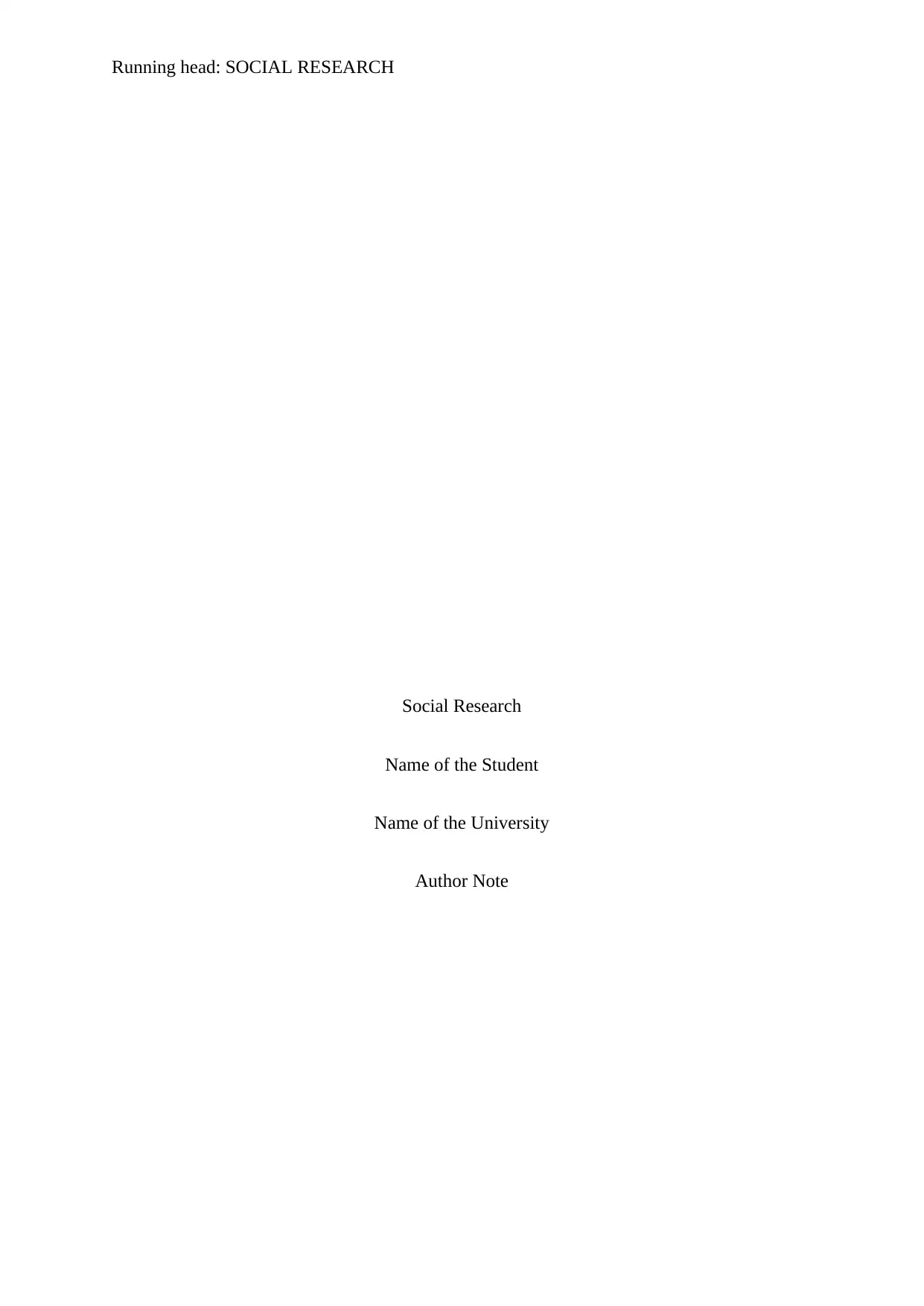
Running head: SOCIAL RESEARCH
Social Research
Name of the Student
Name of the University
Author Note
Social Research
Name of the Student
Name of the University
Author Note
Secure Best Marks with AI Grader
Need help grading? Try our AI Grader for instant feedback on your assignments.
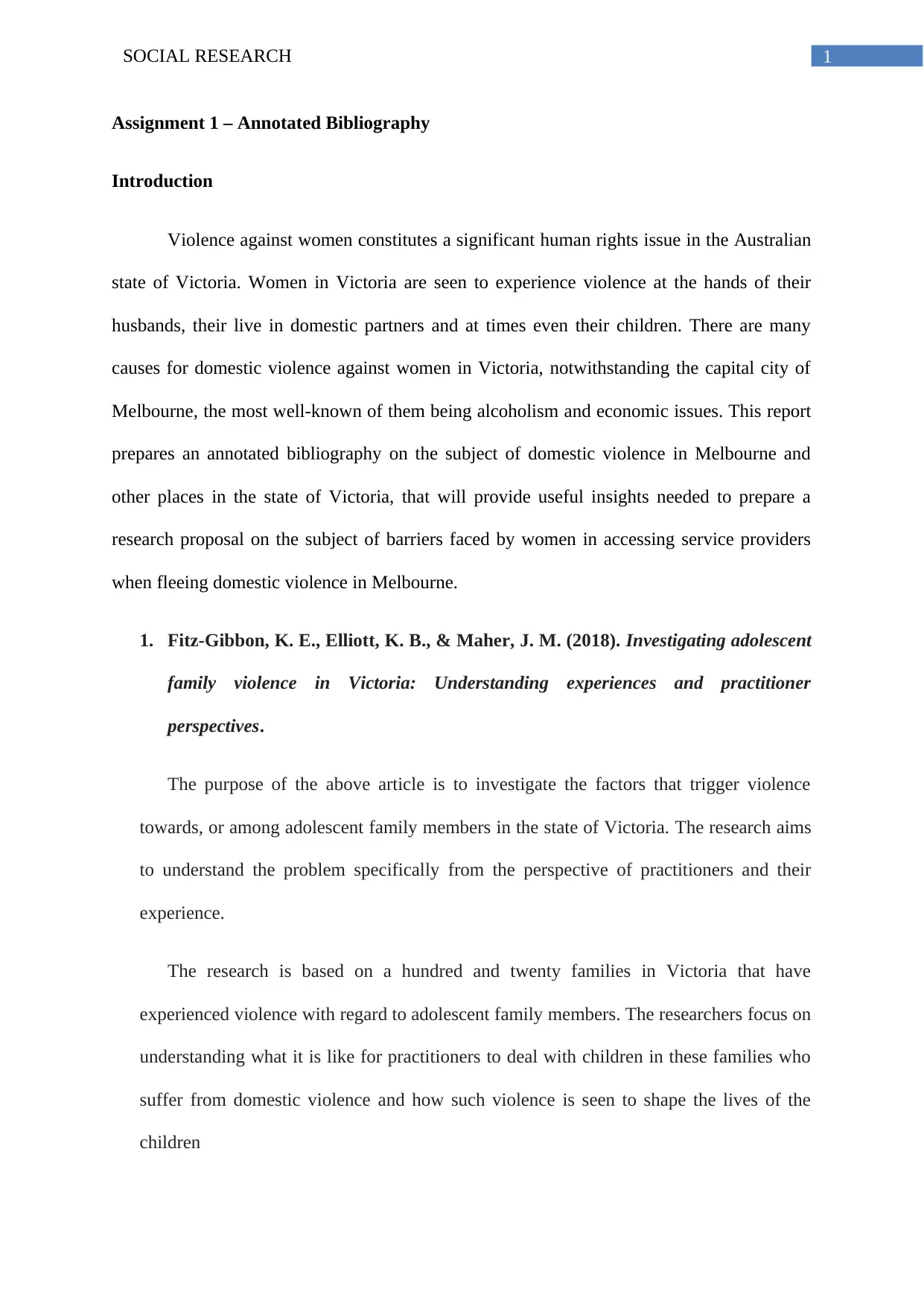
1SOCIAL RESEARCH
Assignment 1 – Annotated Bibliography
Introduction
Violence against women constitutes a significant human rights issue in the Australian
state of Victoria. Women in Victoria are seen to experience violence at the hands of their
husbands, their live in domestic partners and at times even their children. There are many
causes for domestic violence against women in Victoria, notwithstanding the capital city of
Melbourne, the most well-known of them being alcoholism and economic issues. This report
prepares an annotated bibliography on the subject of domestic violence in Melbourne and
other places in the state of Victoria, that will provide useful insights needed to prepare a
research proposal on the subject of barriers faced by women in accessing service providers
when fleeing domestic violence in Melbourne.
1. Fitz-Gibbon, K. E., Elliott, K. B., & Maher, J. M. (2018). Investigating adolescent
family violence in Victoria: Understanding experiences and practitioner
perspectives.
The purpose of the above article is to investigate the factors that trigger violence
towards, or among adolescent family members in the state of Victoria. The research aims
to understand the problem specifically from the perspective of practitioners and their
experience.
The research is based on a hundred and twenty families in Victoria that have
experienced violence with regard to adolescent family members. The researchers focus on
understanding what it is like for practitioners to deal with children in these families who
suffer from domestic violence and how such violence is seen to shape the lives of the
children
Assignment 1 – Annotated Bibliography
Introduction
Violence against women constitutes a significant human rights issue in the Australian
state of Victoria. Women in Victoria are seen to experience violence at the hands of their
husbands, their live in domestic partners and at times even their children. There are many
causes for domestic violence against women in Victoria, notwithstanding the capital city of
Melbourne, the most well-known of them being alcoholism and economic issues. This report
prepares an annotated bibliography on the subject of domestic violence in Melbourne and
other places in the state of Victoria, that will provide useful insights needed to prepare a
research proposal on the subject of barriers faced by women in accessing service providers
when fleeing domestic violence in Melbourne.
1. Fitz-Gibbon, K. E., Elliott, K. B., & Maher, J. M. (2018). Investigating adolescent
family violence in Victoria: Understanding experiences and practitioner
perspectives.
The purpose of the above article is to investigate the factors that trigger violence
towards, or among adolescent family members in the state of Victoria. The research aims
to understand the problem specifically from the perspective of practitioners and their
experience.
The research is based on a hundred and twenty families in Victoria that have
experienced violence with regard to adolescent family members. The researchers focus on
understanding what it is like for practitioners to deal with children in these families who
suffer from domestic violence and how such violence is seen to shape the lives of the
children
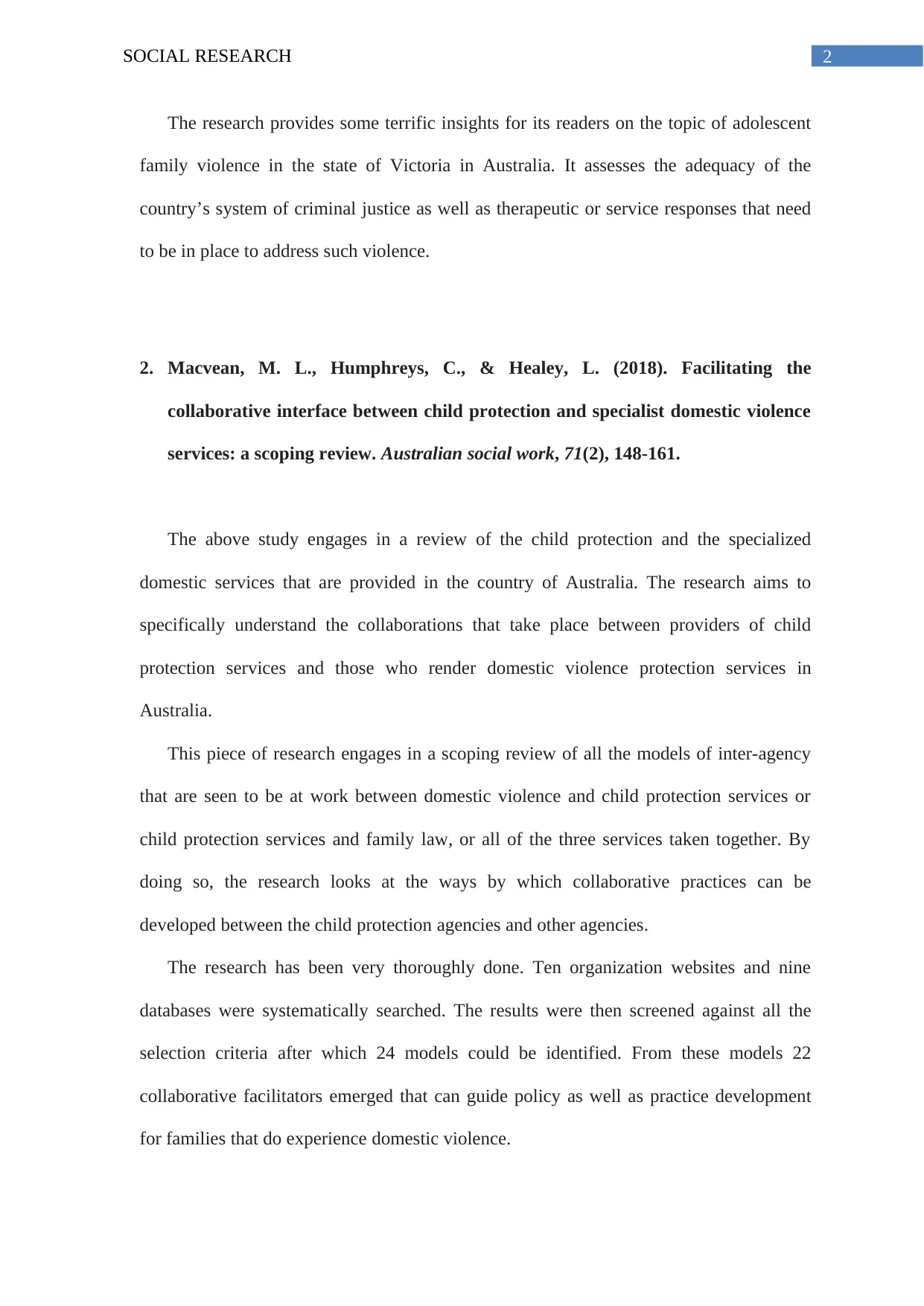
2SOCIAL RESEARCH
The research provides some terrific insights for its readers on the topic of adolescent
family violence in the state of Victoria in Australia. It assesses the adequacy of the
country’s system of criminal justice as well as therapeutic or service responses that need
to be in place to address such violence.
2. Macvean, M. L., Humphreys, C., & Healey, L. (2018). Facilitating the
collaborative interface between child protection and specialist domestic violence
services: a scoping review. Australian social work, 71(2), 148-161.
The above study engages in a review of the child protection and the specialized
domestic services that are provided in the country of Australia. The research aims to
specifically understand the collaborations that take place between providers of child
protection services and those who render domestic violence protection services in
Australia.
This piece of research engages in a scoping review of all the models of inter-agency
that are seen to be at work between domestic violence and child protection services or
child protection services and family law, or all of the three services taken together. By
doing so, the research looks at the ways by which collaborative practices can be
developed between the child protection agencies and other agencies.
The research has been very thoroughly done. Ten organization websites and nine
databases were systematically searched. The results were then screened against all the
selection criteria after which 24 models could be identified. From these models 22
collaborative facilitators emerged that can guide policy as well as practice development
for families that do experience domestic violence.
The research provides some terrific insights for its readers on the topic of adolescent
family violence in the state of Victoria in Australia. It assesses the adequacy of the
country’s system of criminal justice as well as therapeutic or service responses that need
to be in place to address such violence.
2. Macvean, M. L., Humphreys, C., & Healey, L. (2018). Facilitating the
collaborative interface between child protection and specialist domestic violence
services: a scoping review. Australian social work, 71(2), 148-161.
The above study engages in a review of the child protection and the specialized
domestic services that are provided in the country of Australia. The research aims to
specifically understand the collaborations that take place between providers of child
protection services and those who render domestic violence protection services in
Australia.
This piece of research engages in a scoping review of all the models of inter-agency
that are seen to be at work between domestic violence and child protection services or
child protection services and family law, or all of the three services taken together. By
doing so, the research looks at the ways by which collaborative practices can be
developed between the child protection agencies and other agencies.
The research has been very thoroughly done. Ten organization websites and nine
databases were systematically searched. The results were then screened against all the
selection criteria after which 24 models could be identified. From these models 22
collaborative facilitators emerged that can guide policy as well as practice development
for families that do experience domestic violence.
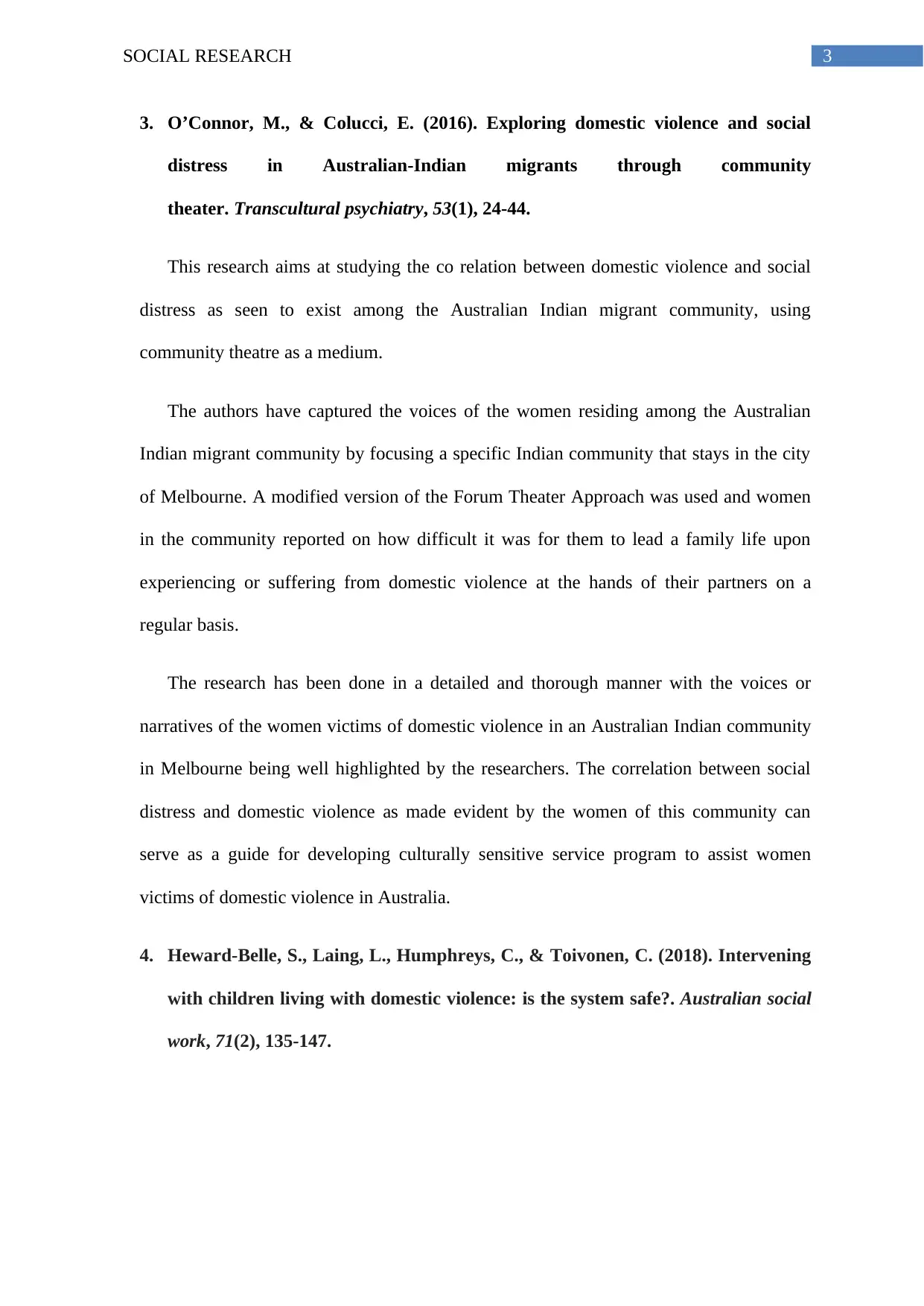
3SOCIAL RESEARCH
3. O’Connor, M., & Colucci, E. (2016). Exploring domestic violence and social
distress in Australian-Indian migrants through community
theater. Transcultural psychiatry, 53(1), 24-44.
This research aims at studying the co relation between domestic violence and social
distress as seen to exist among the Australian Indian migrant community, using
community theatre as a medium.
The authors have captured the voices of the women residing among the Australian
Indian migrant community by focusing a specific Indian community that stays in the city
of Melbourne. A modified version of the Forum Theater Approach was used and women
in the community reported on how difficult it was for them to lead a family life upon
experiencing or suffering from domestic violence at the hands of their partners on a
regular basis.
The research has been done in a detailed and thorough manner with the voices or
narratives of the women victims of domestic violence in an Australian Indian community
in Melbourne being well highlighted by the researchers. The correlation between social
distress and domestic violence as made evident by the women of this community can
serve as a guide for developing culturally sensitive service program to assist women
victims of domestic violence in Australia.
4. Heward-Belle, S., Laing, L., Humphreys, C., & Toivonen, C. (2018). Intervening
with children living with domestic violence: is the system safe?. Australian social
work, 71(2), 135-147.
3. O’Connor, M., & Colucci, E. (2016). Exploring domestic violence and social
distress in Australian-Indian migrants through community
theater. Transcultural psychiatry, 53(1), 24-44.
This research aims at studying the co relation between domestic violence and social
distress as seen to exist among the Australian Indian migrant community, using
community theatre as a medium.
The authors have captured the voices of the women residing among the Australian
Indian migrant community by focusing a specific Indian community that stays in the city
of Melbourne. A modified version of the Forum Theater Approach was used and women
in the community reported on how difficult it was for them to lead a family life upon
experiencing or suffering from domestic violence at the hands of their partners on a
regular basis.
The research has been done in a detailed and thorough manner with the voices or
narratives of the women victims of domestic violence in an Australian Indian community
in Melbourne being well highlighted by the researchers. The correlation between social
distress and domestic violence as made evident by the women of this community can
serve as a guide for developing culturally sensitive service program to assist women
victims of domestic violence in Australia.
4. Heward-Belle, S., Laing, L., Humphreys, C., & Toivonen, C. (2018). Intervening
with children living with domestic violence: is the system safe?. Australian social
work, 71(2), 135-147.
Secure Best Marks with AI Grader
Need help grading? Try our AI Grader for instant feedback on your assignments.
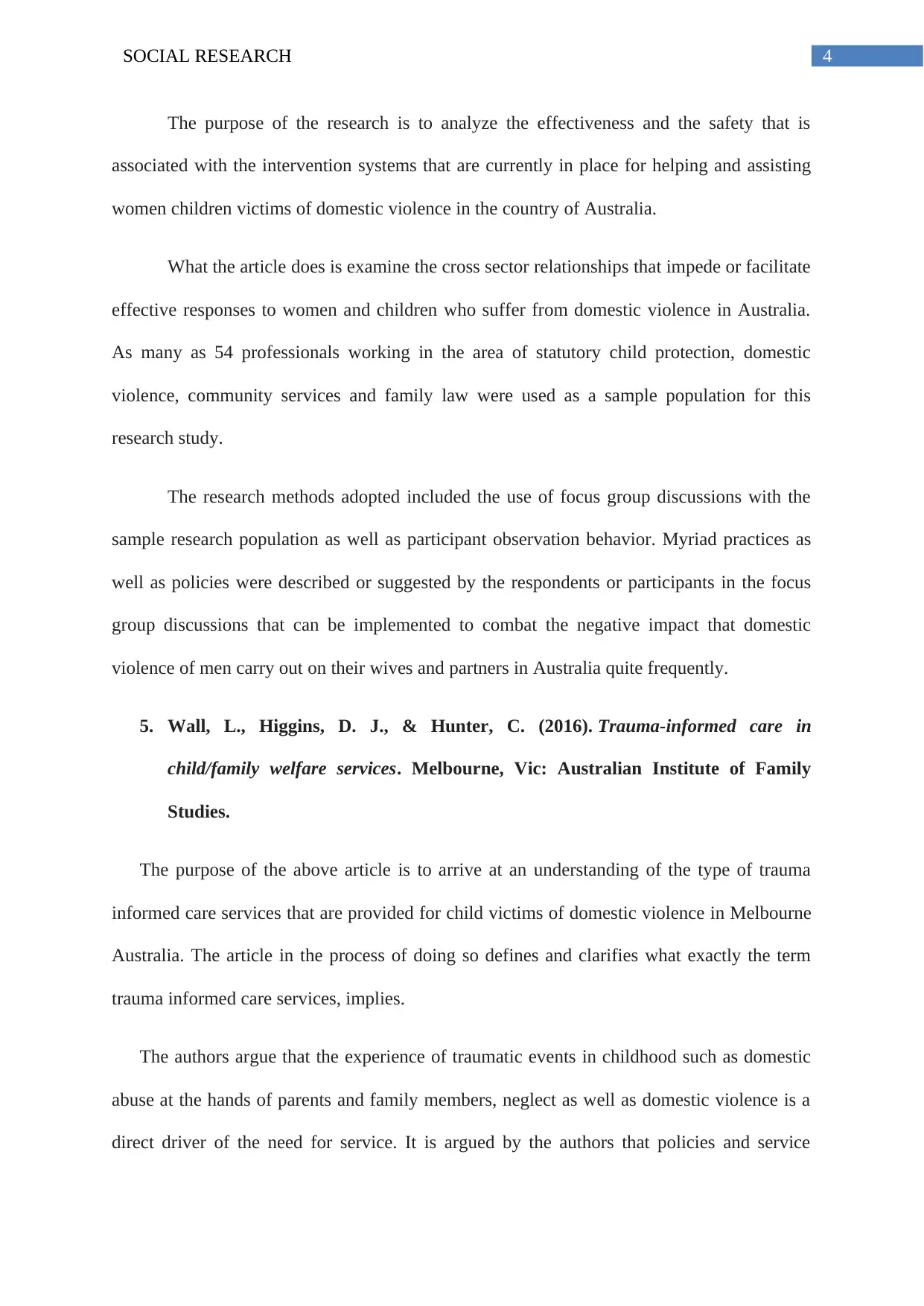
4SOCIAL RESEARCH
The purpose of the research is to analyze the effectiveness and the safety that is
associated with the intervention systems that are currently in place for helping and assisting
women children victims of domestic violence in the country of Australia.
What the article does is examine the cross sector relationships that impede or facilitate
effective responses to women and children who suffer from domestic violence in Australia.
As many as 54 professionals working in the area of statutory child protection, domestic
violence, community services and family law were used as a sample population for this
research study.
The research methods adopted included the use of focus group discussions with the
sample research population as well as participant observation behavior. Myriad practices as
well as policies were described or suggested by the respondents or participants in the focus
group discussions that can be implemented to combat the negative impact that domestic
violence of men carry out on their wives and partners in Australia quite frequently.
5. Wall, L., Higgins, D. J., & Hunter, C. (2016). Trauma-informed care in
child/family welfare services. Melbourne, Vic: Australian Institute of Family
Studies.
The purpose of the above article is to arrive at an understanding of the type of trauma
informed care services that are provided for child victims of domestic violence in Melbourne
Australia. The article in the process of doing so defines and clarifies what exactly the term
trauma informed care services, implies.
The authors argue that the experience of traumatic events in childhood such as domestic
abuse at the hands of parents and family members, neglect as well as domestic violence is a
direct driver of the need for service. It is argued by the authors that policies and service
The purpose of the research is to analyze the effectiveness and the safety that is
associated with the intervention systems that are currently in place for helping and assisting
women children victims of domestic violence in the country of Australia.
What the article does is examine the cross sector relationships that impede or facilitate
effective responses to women and children who suffer from domestic violence in Australia.
As many as 54 professionals working in the area of statutory child protection, domestic
violence, community services and family law were used as a sample population for this
research study.
The research methods adopted included the use of focus group discussions with the
sample research population as well as participant observation behavior. Myriad practices as
well as policies were described or suggested by the respondents or participants in the focus
group discussions that can be implemented to combat the negative impact that domestic
violence of men carry out on their wives and partners in Australia quite frequently.
5. Wall, L., Higgins, D. J., & Hunter, C. (2016). Trauma-informed care in
child/family welfare services. Melbourne, Vic: Australian Institute of Family
Studies.
The purpose of the above article is to arrive at an understanding of the type of trauma
informed care services that are provided for child victims of domestic violence in Melbourne
Australia. The article in the process of doing so defines and clarifies what exactly the term
trauma informed care services, implies.
The authors argue that the experience of traumatic events in childhood such as domestic
abuse at the hands of parents and family members, neglect as well as domestic violence is a
direct driver of the need for service. It is argued by the authors that policies and service
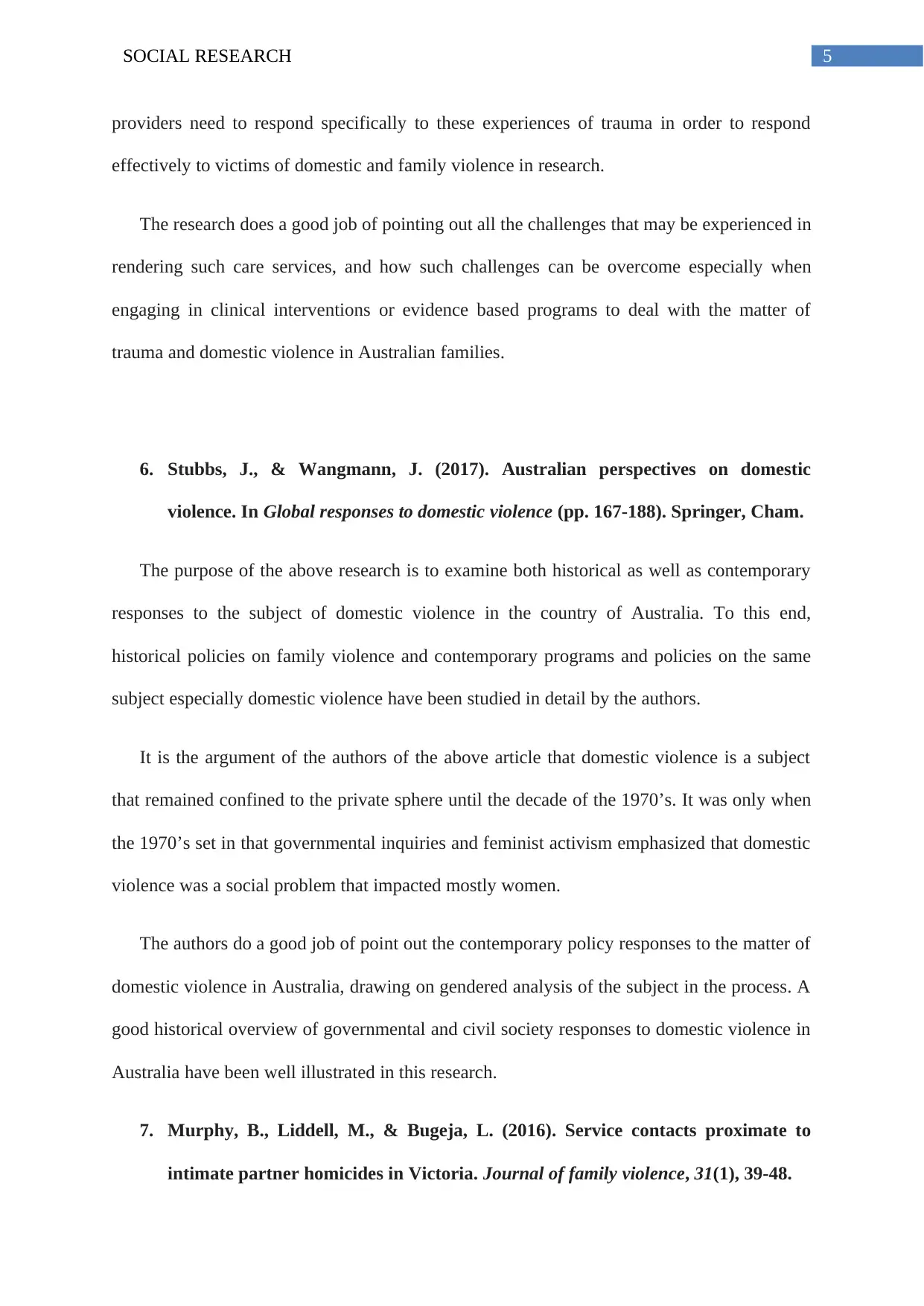
5SOCIAL RESEARCH
providers need to respond specifically to these experiences of trauma in order to respond
effectively to victims of domestic and family violence in research.
The research does a good job of pointing out all the challenges that may be experienced in
rendering such care services, and how such challenges can be overcome especially when
engaging in clinical interventions or evidence based programs to deal with the matter of
trauma and domestic violence in Australian families.
6. Stubbs, J., & Wangmann, J. (2017). Australian perspectives on domestic
violence. In Global responses to domestic violence (pp. 167-188). Springer, Cham.
The purpose of the above research is to examine both historical as well as contemporary
responses to the subject of domestic violence in the country of Australia. To this end,
historical policies on family violence and contemporary programs and policies on the same
subject especially domestic violence have been studied in detail by the authors.
It is the argument of the authors of the above article that domestic violence is a subject
that remained confined to the private sphere until the decade of the 1970’s. It was only when
the 1970’s set in that governmental inquiries and feminist activism emphasized that domestic
violence was a social problem that impacted mostly women.
The authors do a good job of point out the contemporary policy responses to the matter of
domestic violence in Australia, drawing on gendered analysis of the subject in the process. A
good historical overview of governmental and civil society responses to domestic violence in
Australia have been well illustrated in this research.
7. Murphy, B., Liddell, M., & Bugeja, L. (2016). Service contacts proximate to
intimate partner homicides in Victoria. Journal of family violence, 31(1), 39-48.
providers need to respond specifically to these experiences of trauma in order to respond
effectively to victims of domestic and family violence in research.
The research does a good job of pointing out all the challenges that may be experienced in
rendering such care services, and how such challenges can be overcome especially when
engaging in clinical interventions or evidence based programs to deal with the matter of
trauma and domestic violence in Australian families.
6. Stubbs, J., & Wangmann, J. (2017). Australian perspectives on domestic
violence. In Global responses to domestic violence (pp. 167-188). Springer, Cham.
The purpose of the above research is to examine both historical as well as contemporary
responses to the subject of domestic violence in the country of Australia. To this end,
historical policies on family violence and contemporary programs and policies on the same
subject especially domestic violence have been studied in detail by the authors.
It is the argument of the authors of the above article that domestic violence is a subject
that remained confined to the private sphere until the decade of the 1970’s. It was only when
the 1970’s set in that governmental inquiries and feminist activism emphasized that domestic
violence was a social problem that impacted mostly women.
The authors do a good job of point out the contemporary policy responses to the matter of
domestic violence in Australia, drawing on gendered analysis of the subject in the process. A
good historical overview of governmental and civil society responses to domestic violence in
Australia have been well illustrated in this research.
7. Murphy, B., Liddell, M., & Bugeja, L. (2016). Service contacts proximate to
intimate partner homicides in Victoria. Journal of family violence, 31(1), 39-48.
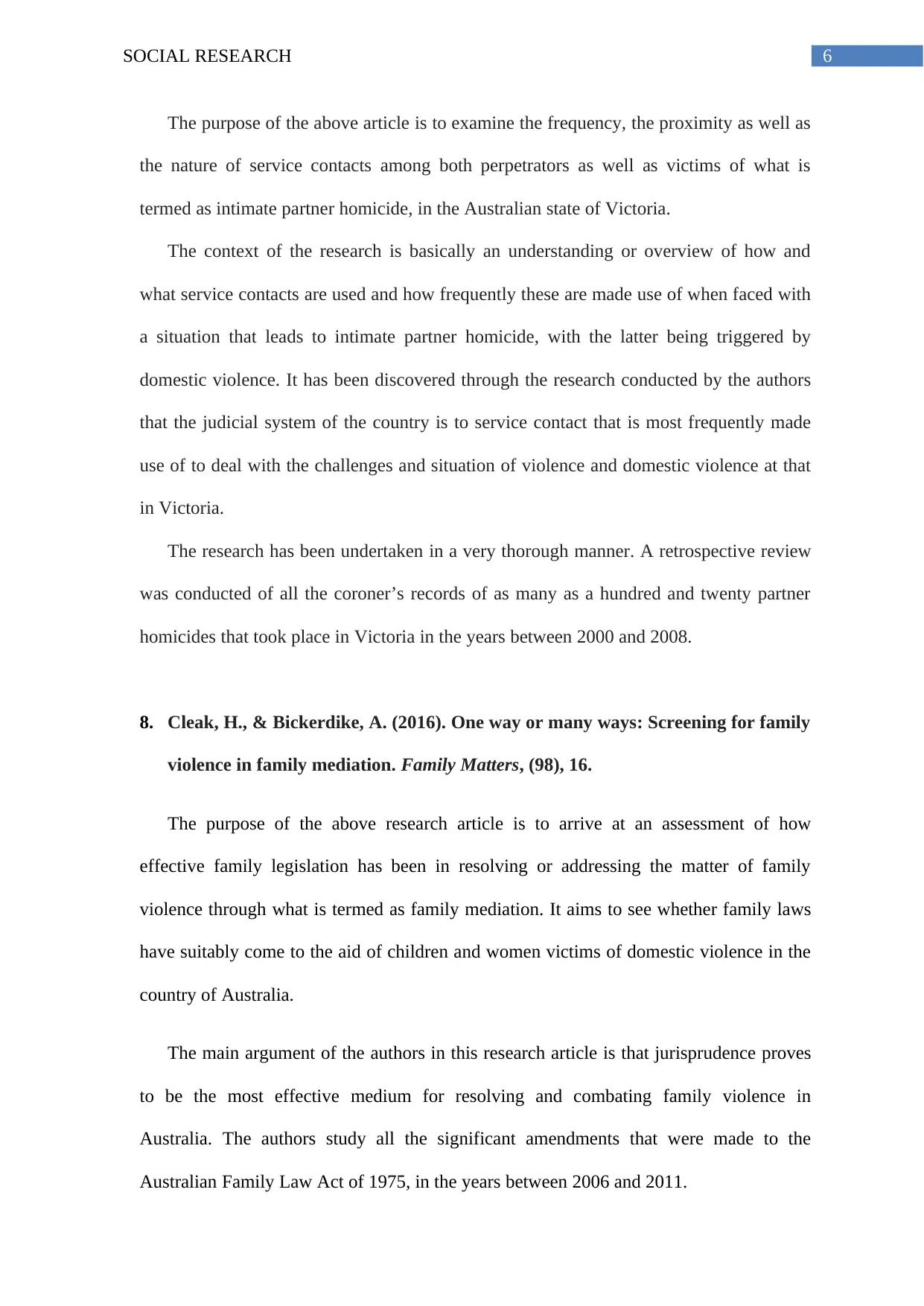
6SOCIAL RESEARCH
The purpose of the above article is to examine the frequency, the proximity as well as
the nature of service contacts among both perpetrators as well as victims of what is
termed as intimate partner homicide, in the Australian state of Victoria.
The context of the research is basically an understanding or overview of how and
what service contacts are used and how frequently these are made use of when faced with
a situation that leads to intimate partner homicide, with the latter being triggered by
domestic violence. It has been discovered through the research conducted by the authors
that the judicial system of the country is to service contact that is most frequently made
use of to deal with the challenges and situation of violence and domestic violence at that
in Victoria.
The research has been undertaken in a very thorough manner. A retrospective review
was conducted of all the coroner’s records of as many as a hundred and twenty partner
homicides that took place in Victoria in the years between 2000 and 2008.
8. Cleak, H., & Bickerdike, A. (2016). One way or many ways: Screening for family
violence in family mediation. Family Matters, (98), 16.
The purpose of the above research article is to arrive at an assessment of how
effective family legislation has been in resolving or addressing the matter of family
violence through what is termed as family mediation. It aims to see whether family laws
have suitably come to the aid of children and women victims of domestic violence in the
country of Australia.
The main argument of the authors in this research article is that jurisprudence proves
to be the most effective medium for resolving and combating family violence in
Australia. The authors study all the significant amendments that were made to the
Australian Family Law Act of 1975, in the years between 2006 and 2011.
The purpose of the above article is to examine the frequency, the proximity as well as
the nature of service contacts among both perpetrators as well as victims of what is
termed as intimate partner homicide, in the Australian state of Victoria.
The context of the research is basically an understanding or overview of how and
what service contacts are used and how frequently these are made use of when faced with
a situation that leads to intimate partner homicide, with the latter being triggered by
domestic violence. It has been discovered through the research conducted by the authors
that the judicial system of the country is to service contact that is most frequently made
use of to deal with the challenges and situation of violence and domestic violence at that
in Victoria.
The research has been undertaken in a very thorough manner. A retrospective review
was conducted of all the coroner’s records of as many as a hundred and twenty partner
homicides that took place in Victoria in the years between 2000 and 2008.
8. Cleak, H., & Bickerdike, A. (2016). One way or many ways: Screening for family
violence in family mediation. Family Matters, (98), 16.
The purpose of the above research article is to arrive at an assessment of how
effective family legislation has been in resolving or addressing the matter of family
violence through what is termed as family mediation. It aims to see whether family laws
have suitably come to the aid of children and women victims of domestic violence in the
country of Australia.
The main argument of the authors in this research article is that jurisprudence proves
to be the most effective medium for resolving and combating family violence in
Australia. The authors study all the significant amendments that were made to the
Australian Family Law Act of 1975, in the years between 2006 and 2011.
Paraphrase This Document
Need a fresh take? Get an instant paraphrase of this document with our AI Paraphraser

7SOCIAL RESEARCH
The authors have done a thorough job of reviewing all the legislations, concluding the
process that the changes brought about in legislation led to a decrease by twenty five
percent in the court filings with regard to parent matters in instances of domestic violence
in Australia.
The authors have done a thorough job of reviewing all the legislations, concluding the
process that the changes brought about in legislation led to a decrease by twenty five
percent in the court filings with regard to parent matters in instances of domestic violence
in Australia.
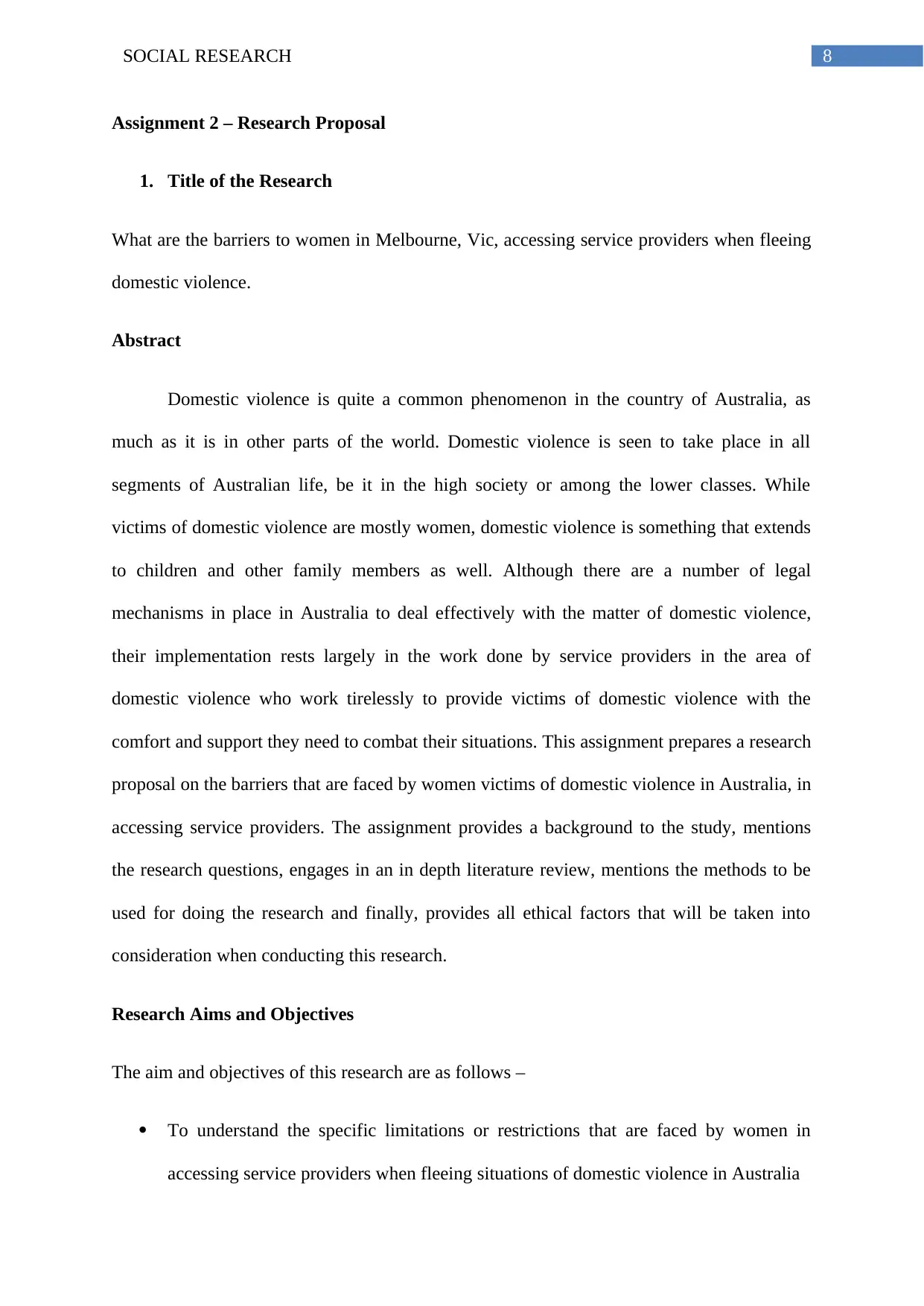
8SOCIAL RESEARCH
Assignment 2 – Research Proposal
1. Title of the Research
What are the barriers to women in Melbourne, Vic, accessing service providers when fleeing
domestic violence.
Abstract
Domestic violence is quite a common phenomenon in the country of Australia, as
much as it is in other parts of the world. Domestic violence is seen to take place in all
segments of Australian life, be it in the high society or among the lower classes. While
victims of domestic violence are mostly women, domestic violence is something that extends
to children and other family members as well. Although there are a number of legal
mechanisms in place in Australia to deal effectively with the matter of domestic violence,
their implementation rests largely in the work done by service providers in the area of
domestic violence who work tirelessly to provide victims of domestic violence with the
comfort and support they need to combat their situations. This assignment prepares a research
proposal on the barriers that are faced by women victims of domestic violence in Australia, in
accessing service providers. The assignment provides a background to the study, mentions
the research questions, engages in an in depth literature review, mentions the methods to be
used for doing the research and finally, provides all ethical factors that will be taken into
consideration when conducting this research.
Research Aims and Objectives
The aim and objectives of this research are as follows –
To understand the specific limitations or restrictions that are faced by women in
accessing service providers when fleeing situations of domestic violence in Australia
Assignment 2 – Research Proposal
1. Title of the Research
What are the barriers to women in Melbourne, Vic, accessing service providers when fleeing
domestic violence.
Abstract
Domestic violence is quite a common phenomenon in the country of Australia, as
much as it is in other parts of the world. Domestic violence is seen to take place in all
segments of Australian life, be it in the high society or among the lower classes. While
victims of domestic violence are mostly women, domestic violence is something that extends
to children and other family members as well. Although there are a number of legal
mechanisms in place in Australia to deal effectively with the matter of domestic violence,
their implementation rests largely in the work done by service providers in the area of
domestic violence who work tirelessly to provide victims of domestic violence with the
comfort and support they need to combat their situations. This assignment prepares a research
proposal on the barriers that are faced by women victims of domestic violence in Australia, in
accessing service providers. The assignment provides a background to the study, mentions
the research questions, engages in an in depth literature review, mentions the methods to be
used for doing the research and finally, provides all ethical factors that will be taken into
consideration when conducting this research.
Research Aims and Objectives
The aim and objectives of this research are as follows –
To understand the specific limitations or restrictions that are faced by women in
accessing service providers when fleeing situations of domestic violence in Australia
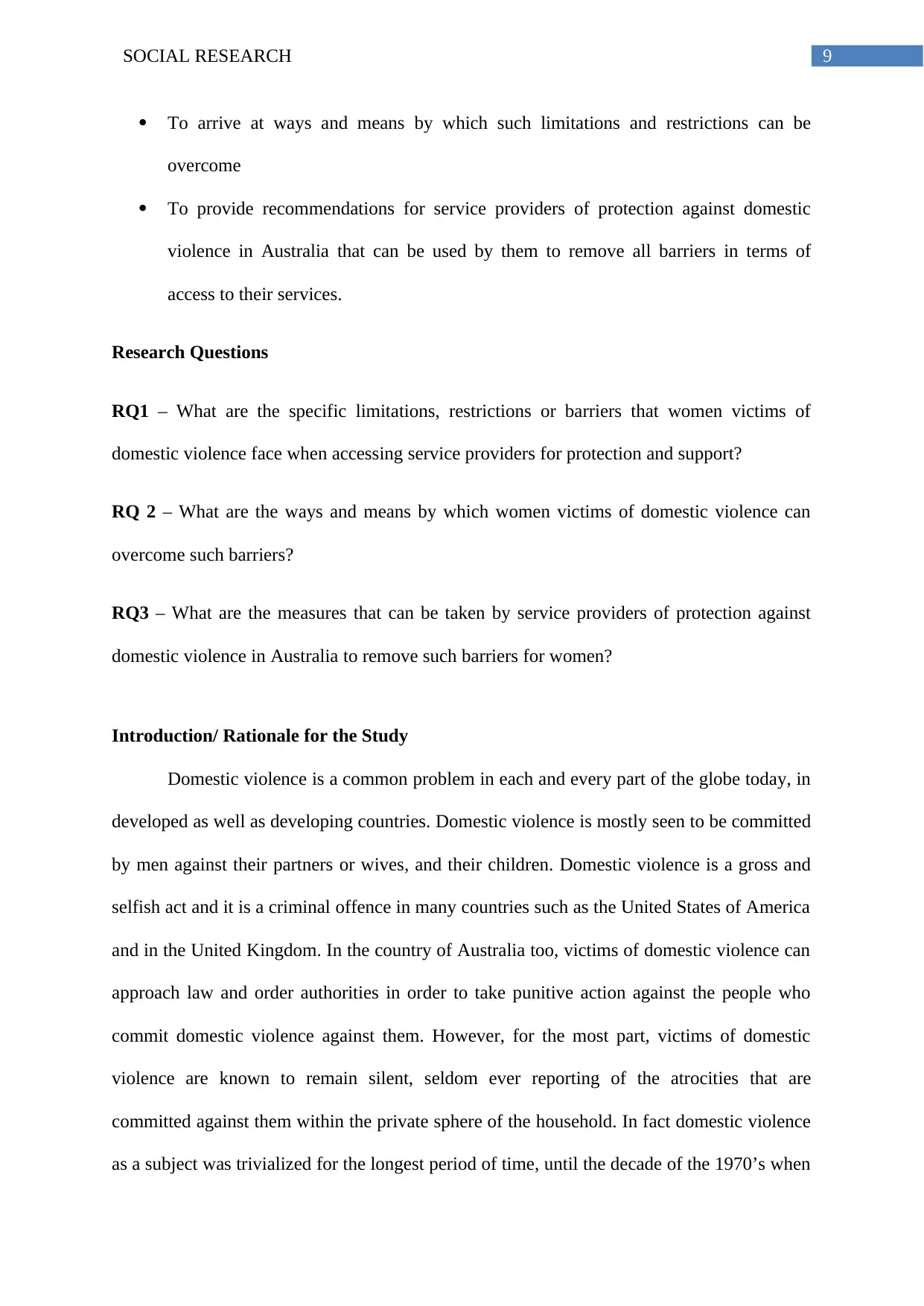
9SOCIAL RESEARCH
To arrive at ways and means by which such limitations and restrictions can be
overcome
To provide recommendations for service providers of protection against domestic
violence in Australia that can be used by them to remove all barriers in terms of
access to their services.
Research Questions
RQ1 – What are the specific limitations, restrictions or barriers that women victims of
domestic violence face when accessing service providers for protection and support?
RQ 2 – What are the ways and means by which women victims of domestic violence can
overcome such barriers?
RQ3 – What are the measures that can be taken by service providers of protection against
domestic violence in Australia to remove such barriers for women?
Introduction/ Rationale for the Study
Domestic violence is a common problem in each and every part of the globe today, in
developed as well as developing countries. Domestic violence is mostly seen to be committed
by men against their partners or wives, and their children. Domestic violence is a gross and
selfish act and it is a criminal offence in many countries such as the United States of America
and in the United Kingdom. In the country of Australia too, victims of domestic violence can
approach law and order authorities in order to take punitive action against the people who
commit domestic violence against them. However, for the most part, victims of domestic
violence are known to remain silent, seldom ever reporting of the atrocities that are
committed against them within the private sphere of the household. In fact domestic violence
as a subject was trivialized for the longest period of time, until the decade of the 1970’s when
To arrive at ways and means by which such limitations and restrictions can be
overcome
To provide recommendations for service providers of protection against domestic
violence in Australia that can be used by them to remove all barriers in terms of
access to their services.
Research Questions
RQ1 – What are the specific limitations, restrictions or barriers that women victims of
domestic violence face when accessing service providers for protection and support?
RQ 2 – What are the ways and means by which women victims of domestic violence can
overcome such barriers?
RQ3 – What are the measures that can be taken by service providers of protection against
domestic violence in Australia to remove such barriers for women?
Introduction/ Rationale for the Study
Domestic violence is a common problem in each and every part of the globe today, in
developed as well as developing countries. Domestic violence is mostly seen to be committed
by men against their partners or wives, and their children. Domestic violence is a gross and
selfish act and it is a criminal offence in many countries such as the United States of America
and in the United Kingdom. In the country of Australia too, victims of domestic violence can
approach law and order authorities in order to take punitive action against the people who
commit domestic violence against them. However, for the most part, victims of domestic
violence are known to remain silent, seldom ever reporting of the atrocities that are
committed against them within the private sphere of the household. In fact domestic violence
as a subject was trivialized for the longest period of time, until the decade of the 1970’s when
Secure Best Marks with AI Grader
Need help grading? Try our AI Grader for instant feedback on your assignments.
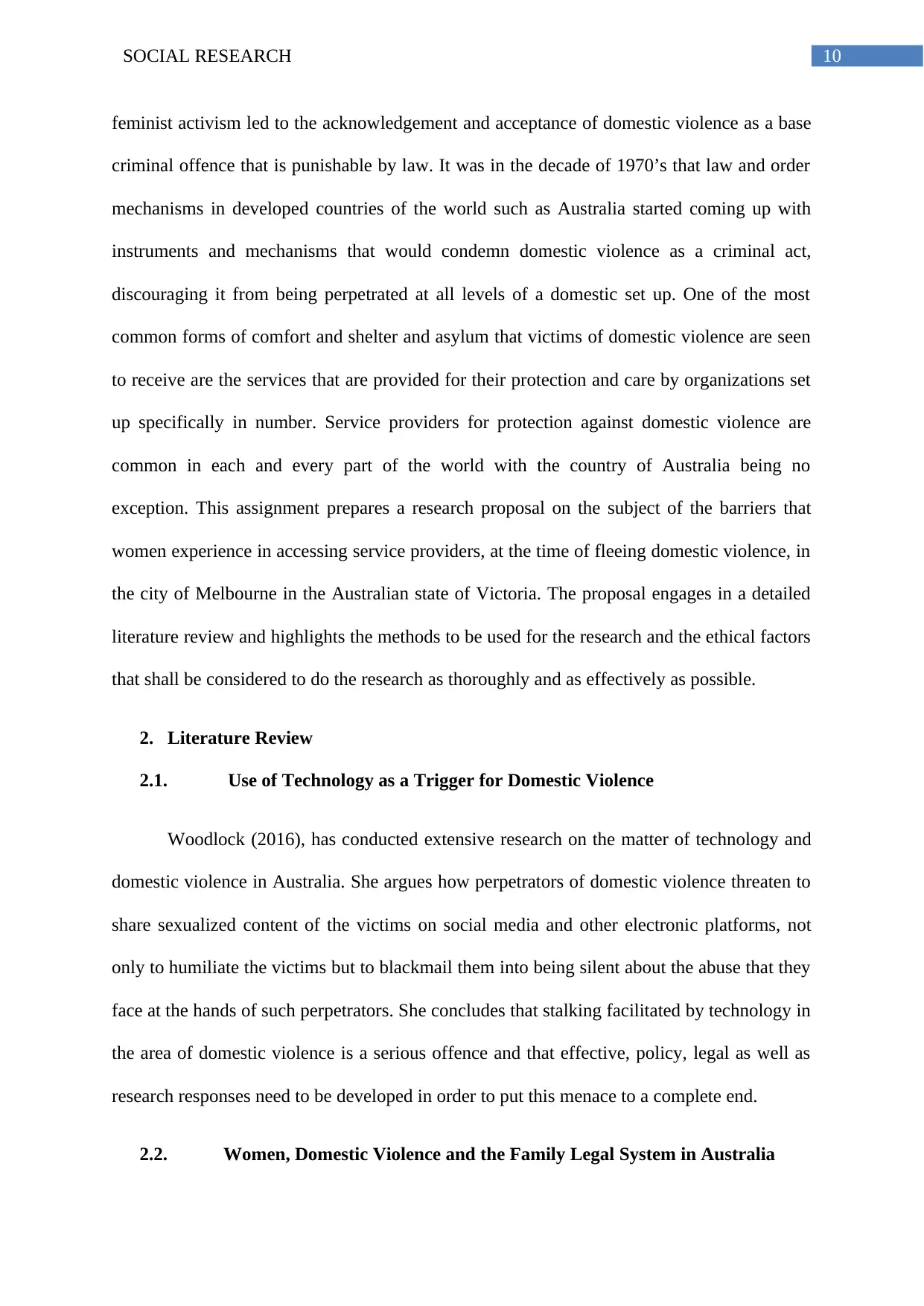
10SOCIAL RESEARCH
feminist activism led to the acknowledgement and acceptance of domestic violence as a base
criminal offence that is punishable by law. It was in the decade of 1970’s that law and order
mechanisms in developed countries of the world such as Australia started coming up with
instruments and mechanisms that would condemn domestic violence as a criminal act,
discouraging it from being perpetrated at all levels of a domestic set up. One of the most
common forms of comfort and shelter and asylum that victims of domestic violence are seen
to receive are the services that are provided for their protection and care by organizations set
up specifically in number. Service providers for protection against domestic violence are
common in each and every part of the world with the country of Australia being no
exception. This assignment prepares a research proposal on the subject of the barriers that
women experience in accessing service providers, at the time of fleeing domestic violence, in
the city of Melbourne in the Australian state of Victoria. The proposal engages in a detailed
literature review and highlights the methods to be used for the research and the ethical factors
that shall be considered to do the research as thoroughly and as effectively as possible.
2. Literature Review
2.1. Use of Technology as a Trigger for Domestic Violence
Woodlock (2016), has conducted extensive research on the matter of technology and
domestic violence in Australia. She argues how perpetrators of domestic violence threaten to
share sexualized content of the victims on social media and other electronic platforms, not
only to humiliate the victims but to blackmail them into being silent about the abuse that they
face at the hands of such perpetrators. She concludes that stalking facilitated by technology in
the area of domestic violence is a serious offence and that effective, policy, legal as well as
research responses need to be developed in order to put this menace to a complete end.
2.2. Women, Domestic Violence and the Family Legal System in Australia
feminist activism led to the acknowledgement and acceptance of domestic violence as a base
criminal offence that is punishable by law. It was in the decade of 1970’s that law and order
mechanisms in developed countries of the world such as Australia started coming up with
instruments and mechanisms that would condemn domestic violence as a criminal act,
discouraging it from being perpetrated at all levels of a domestic set up. One of the most
common forms of comfort and shelter and asylum that victims of domestic violence are seen
to receive are the services that are provided for their protection and care by organizations set
up specifically in number. Service providers for protection against domestic violence are
common in each and every part of the world with the country of Australia being no
exception. This assignment prepares a research proposal on the subject of the barriers that
women experience in accessing service providers, at the time of fleeing domestic violence, in
the city of Melbourne in the Australian state of Victoria. The proposal engages in a detailed
literature review and highlights the methods to be used for the research and the ethical factors
that shall be considered to do the research as thoroughly and as effectively as possible.
2. Literature Review
2.1. Use of Technology as a Trigger for Domestic Violence
Woodlock (2016), has conducted extensive research on the matter of technology and
domestic violence in Australia. She argues how perpetrators of domestic violence threaten to
share sexualized content of the victims on social media and other electronic platforms, not
only to humiliate the victims but to blackmail them into being silent about the abuse that they
face at the hands of such perpetrators. She concludes that stalking facilitated by technology in
the area of domestic violence is a serious offence and that effective, policy, legal as well as
research responses need to be developed in order to put this menace to a complete end.
2.2. Women, Domestic Violence and the Family Legal System in Australia
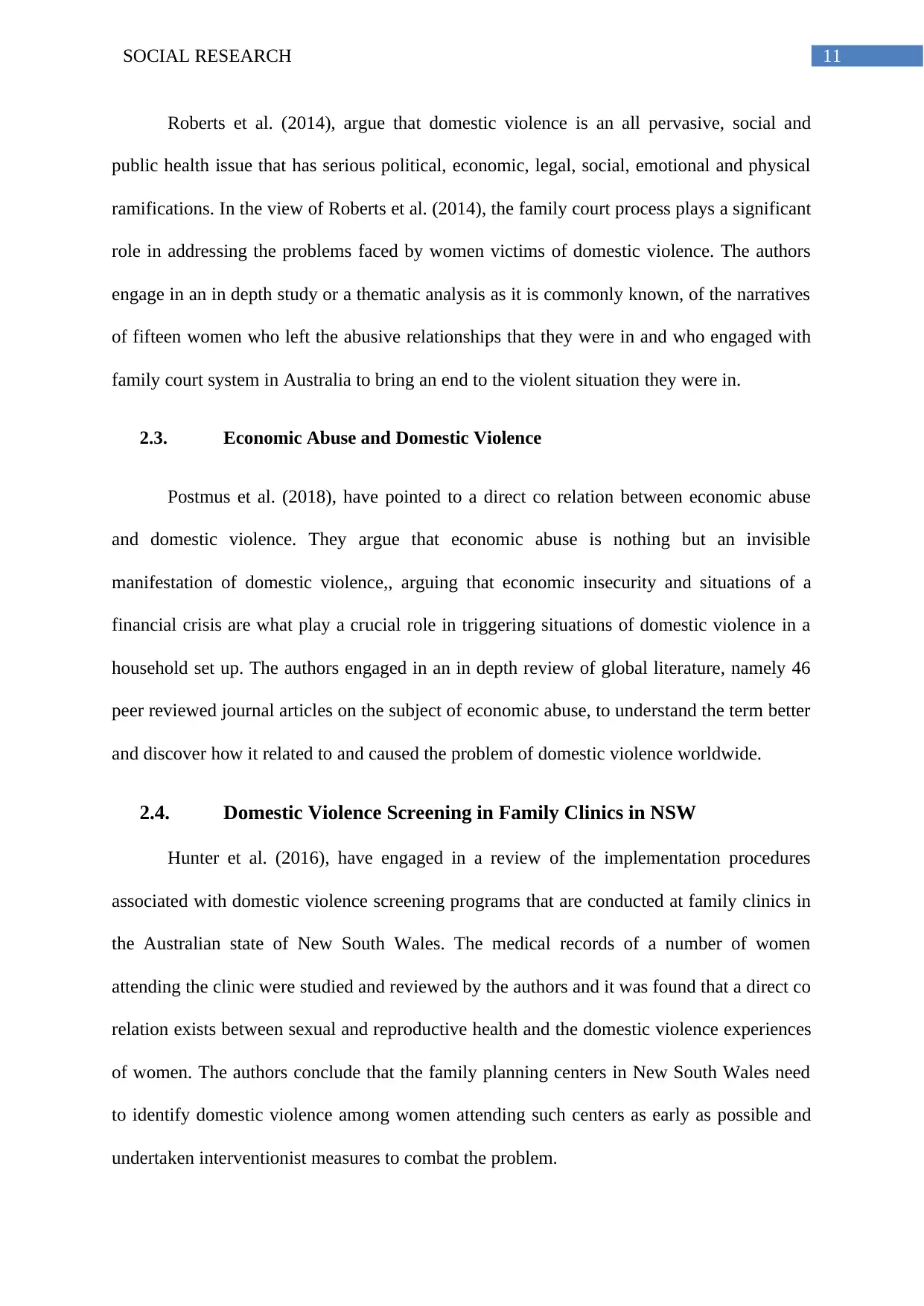
11SOCIAL RESEARCH
Roberts et al. (2014), argue that domestic violence is an all pervasive, social and
public health issue that has serious political, economic, legal, social, emotional and physical
ramifications. In the view of Roberts et al. (2014), the family court process plays a significant
role in addressing the problems faced by women victims of domestic violence. The authors
engage in an in depth study or a thematic analysis as it is commonly known, of the narratives
of fifteen women who left the abusive relationships that they were in and who engaged with
family court system in Australia to bring an end to the violent situation they were in.
2.3. Economic Abuse and Domestic Violence
Postmus et al. (2018), have pointed to a direct co relation between economic abuse
and domestic violence. They argue that economic abuse is nothing but an invisible
manifestation of domestic violence,, arguing that economic insecurity and situations of a
financial crisis are what play a crucial role in triggering situations of domestic violence in a
household set up. The authors engaged in an in depth review of global literature, namely 46
peer reviewed journal articles on the subject of economic abuse, to understand the term better
and discover how it related to and caused the problem of domestic violence worldwide.
2.4. Domestic Violence Screening in Family Clinics in NSW
Hunter et al. (2016), have engaged in a review of the implementation procedures
associated with domestic violence screening programs that are conducted at family clinics in
the Australian state of New South Wales. The medical records of a number of women
attending the clinic were studied and reviewed by the authors and it was found that a direct co
relation exists between sexual and reproductive health and the domestic violence experiences
of women. The authors conclude that the family planning centers in New South Wales need
to identify domestic violence among women attending such centers as early as possible and
undertaken interventionist measures to combat the problem.
Roberts et al. (2014), argue that domestic violence is an all pervasive, social and
public health issue that has serious political, economic, legal, social, emotional and physical
ramifications. In the view of Roberts et al. (2014), the family court process plays a significant
role in addressing the problems faced by women victims of domestic violence. The authors
engage in an in depth study or a thematic analysis as it is commonly known, of the narratives
of fifteen women who left the abusive relationships that they were in and who engaged with
family court system in Australia to bring an end to the violent situation they were in.
2.3. Economic Abuse and Domestic Violence
Postmus et al. (2018), have pointed to a direct co relation between economic abuse
and domestic violence. They argue that economic abuse is nothing but an invisible
manifestation of domestic violence,, arguing that economic insecurity and situations of a
financial crisis are what play a crucial role in triggering situations of domestic violence in a
household set up. The authors engaged in an in depth review of global literature, namely 46
peer reviewed journal articles on the subject of economic abuse, to understand the term better
and discover how it related to and caused the problem of domestic violence worldwide.
2.4. Domestic Violence Screening in Family Clinics in NSW
Hunter et al. (2016), have engaged in a review of the implementation procedures
associated with domestic violence screening programs that are conducted at family clinics in
the Australian state of New South Wales. The medical records of a number of women
attending the clinic were studied and reviewed by the authors and it was found that a direct co
relation exists between sexual and reproductive health and the domestic violence experiences
of women. The authors conclude that the family planning centers in New South Wales need
to identify domestic violence among women attending such centers as early as possible and
undertaken interventionist measures to combat the problem.
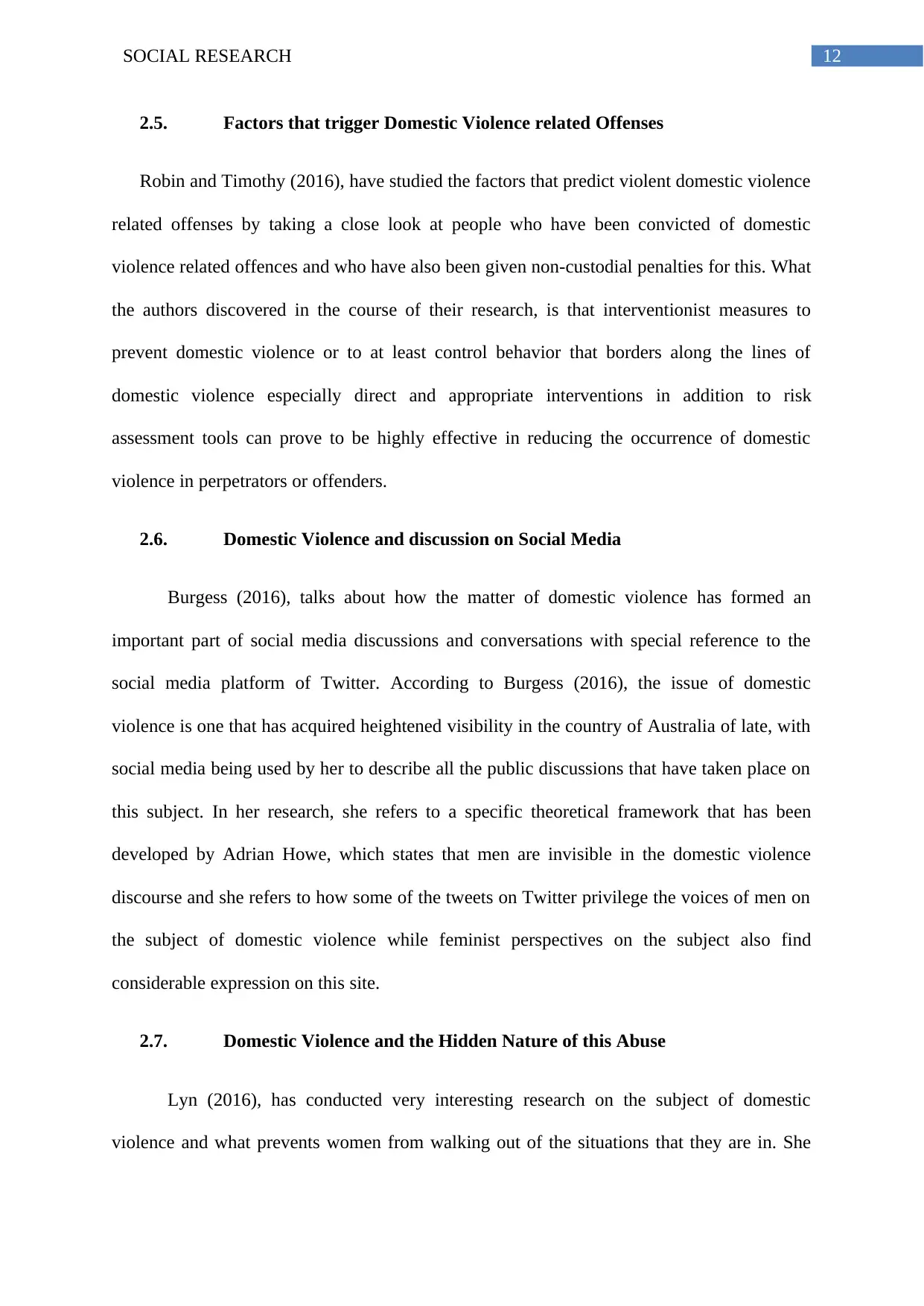
12SOCIAL RESEARCH
2.5. Factors that trigger Domestic Violence related Offenses
Robin and Timothy (2016), have studied the factors that predict violent domestic violence
related offenses by taking a close look at people who have been convicted of domestic
violence related offences and who have also been given non-custodial penalties for this. What
the authors discovered in the course of their research, is that interventionist measures to
prevent domestic violence or to at least control behavior that borders along the lines of
domestic violence especially direct and appropriate interventions in addition to risk
assessment tools can prove to be highly effective in reducing the occurrence of domestic
violence in perpetrators or offenders.
2.6. Domestic Violence and discussion on Social Media
Burgess (2016), talks about how the matter of domestic violence has formed an
important part of social media discussions and conversations with special reference to the
social media platform of Twitter. According to Burgess (2016), the issue of domestic
violence is one that has acquired heightened visibility in the country of Australia of late, with
social media being used by her to describe all the public discussions that have taken place on
this subject. In her research, she refers to a specific theoretical framework that has been
developed by Adrian Howe, which states that men are invisible in the domestic violence
discourse and she refers to how some of the tweets on Twitter privilege the voices of men on
the subject of domestic violence while feminist perspectives on the subject also find
considerable expression on this site.
2.7. Domestic Violence and the Hidden Nature of this Abuse
Lyn (2016), has conducted very interesting research on the subject of domestic
violence and what prevents women from walking out of the situations that they are in. She
2.5. Factors that trigger Domestic Violence related Offenses
Robin and Timothy (2016), have studied the factors that predict violent domestic violence
related offenses by taking a close look at people who have been convicted of domestic
violence related offences and who have also been given non-custodial penalties for this. What
the authors discovered in the course of their research, is that interventionist measures to
prevent domestic violence or to at least control behavior that borders along the lines of
domestic violence especially direct and appropriate interventions in addition to risk
assessment tools can prove to be highly effective in reducing the occurrence of domestic
violence in perpetrators or offenders.
2.6. Domestic Violence and discussion on Social Media
Burgess (2016), talks about how the matter of domestic violence has formed an
important part of social media discussions and conversations with special reference to the
social media platform of Twitter. According to Burgess (2016), the issue of domestic
violence is one that has acquired heightened visibility in the country of Australia of late, with
social media being used by her to describe all the public discussions that have taken place on
this subject. In her research, she refers to a specific theoretical framework that has been
developed by Adrian Howe, which states that men are invisible in the domestic violence
discourse and she refers to how some of the tweets on Twitter privilege the voices of men on
the subject of domestic violence while feminist perspectives on the subject also find
considerable expression on this site.
2.7. Domestic Violence and the Hidden Nature of this Abuse
Lyn (2016), has conducted very interesting research on the subject of domestic
violence and what prevents women from walking out of the situations that they are in. She
Paraphrase This Document
Need a fresh take? Get an instant paraphrase of this document with our AI Paraphraser
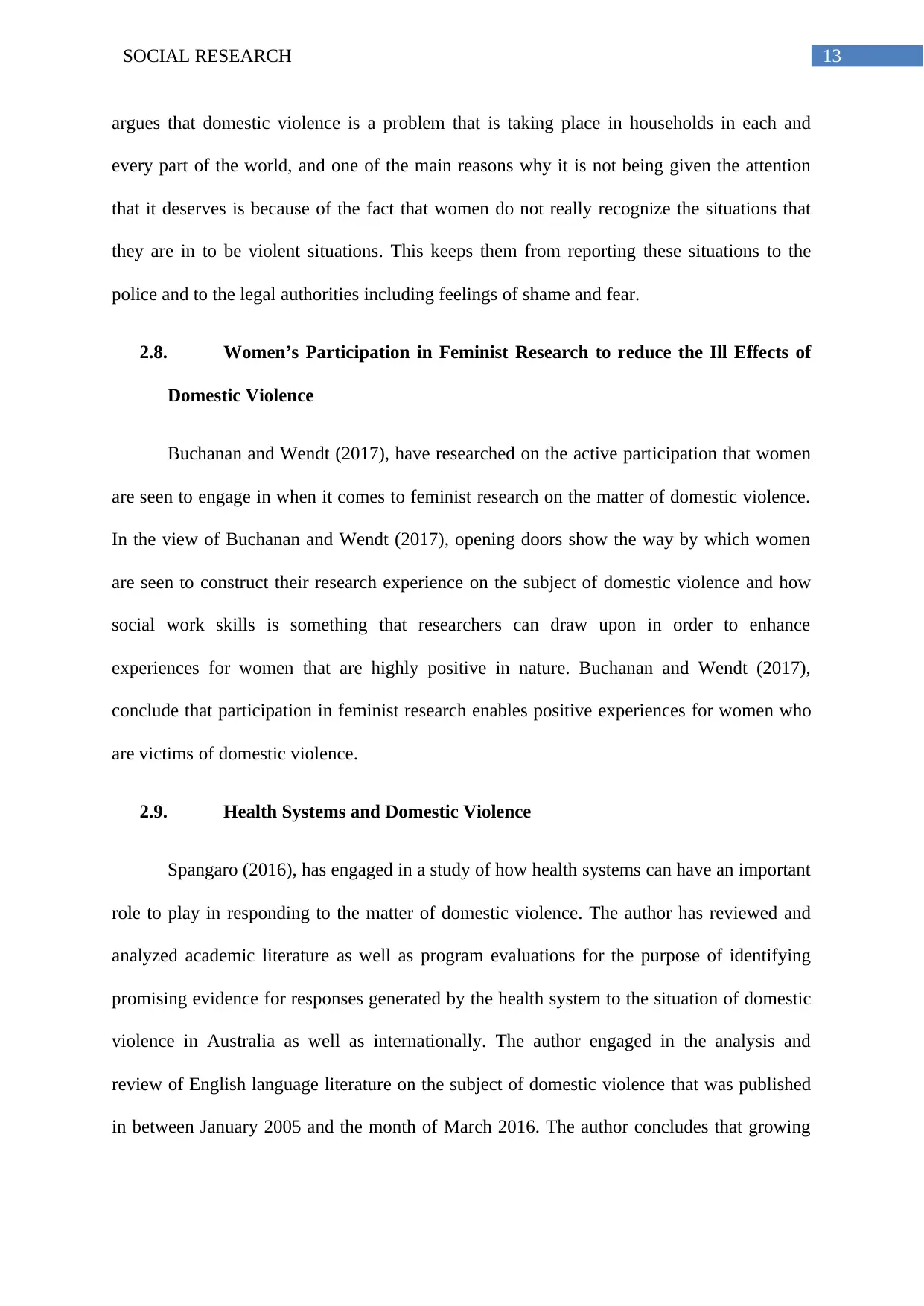
13SOCIAL RESEARCH
argues that domestic violence is a problem that is taking place in households in each and
every part of the world, and one of the main reasons why it is not being given the attention
that it deserves is because of the fact that women do not really recognize the situations that
they are in to be violent situations. This keeps them from reporting these situations to the
police and to the legal authorities including feelings of shame and fear.
2.8. Women’s Participation in Feminist Research to reduce the Ill Effects of
Domestic Violence
Buchanan and Wendt (2017), have researched on the active participation that women
are seen to engage in when it comes to feminist research on the matter of domestic violence.
In the view of Buchanan and Wendt (2017), opening doors show the way by which women
are seen to construct their research experience on the subject of domestic violence and how
social work skills is something that researchers can draw upon in order to enhance
experiences for women that are highly positive in nature. Buchanan and Wendt (2017),
conclude that participation in feminist research enables positive experiences for women who
are victims of domestic violence.
2.9. Health Systems and Domestic Violence
Spangaro (2016), has engaged in a study of how health systems can have an important
role to play in responding to the matter of domestic violence. The author has reviewed and
analyzed academic literature as well as program evaluations for the purpose of identifying
promising evidence for responses generated by the health system to the situation of domestic
violence in Australia as well as internationally. The author engaged in the analysis and
review of English language literature on the subject of domestic violence that was published
in between January 2005 and the month of March 2016. The author concludes that growing
argues that domestic violence is a problem that is taking place in households in each and
every part of the world, and one of the main reasons why it is not being given the attention
that it deserves is because of the fact that women do not really recognize the situations that
they are in to be violent situations. This keeps them from reporting these situations to the
police and to the legal authorities including feelings of shame and fear.
2.8. Women’s Participation in Feminist Research to reduce the Ill Effects of
Domestic Violence
Buchanan and Wendt (2017), have researched on the active participation that women
are seen to engage in when it comes to feminist research on the matter of domestic violence.
In the view of Buchanan and Wendt (2017), opening doors show the way by which women
are seen to construct their research experience on the subject of domestic violence and how
social work skills is something that researchers can draw upon in order to enhance
experiences for women that are highly positive in nature. Buchanan and Wendt (2017),
conclude that participation in feminist research enables positive experiences for women who
are victims of domestic violence.
2.9. Health Systems and Domestic Violence
Spangaro (2016), has engaged in a study of how health systems can have an important
role to play in responding to the matter of domestic violence. The author has reviewed and
analyzed academic literature as well as program evaluations for the purpose of identifying
promising evidence for responses generated by the health system to the situation of domestic
violence in Australia as well as internationally. The author engaged in the analysis and
review of English language literature on the subject of domestic violence that was published
in between January 2005 and the month of March 2016. The author concludes that growing
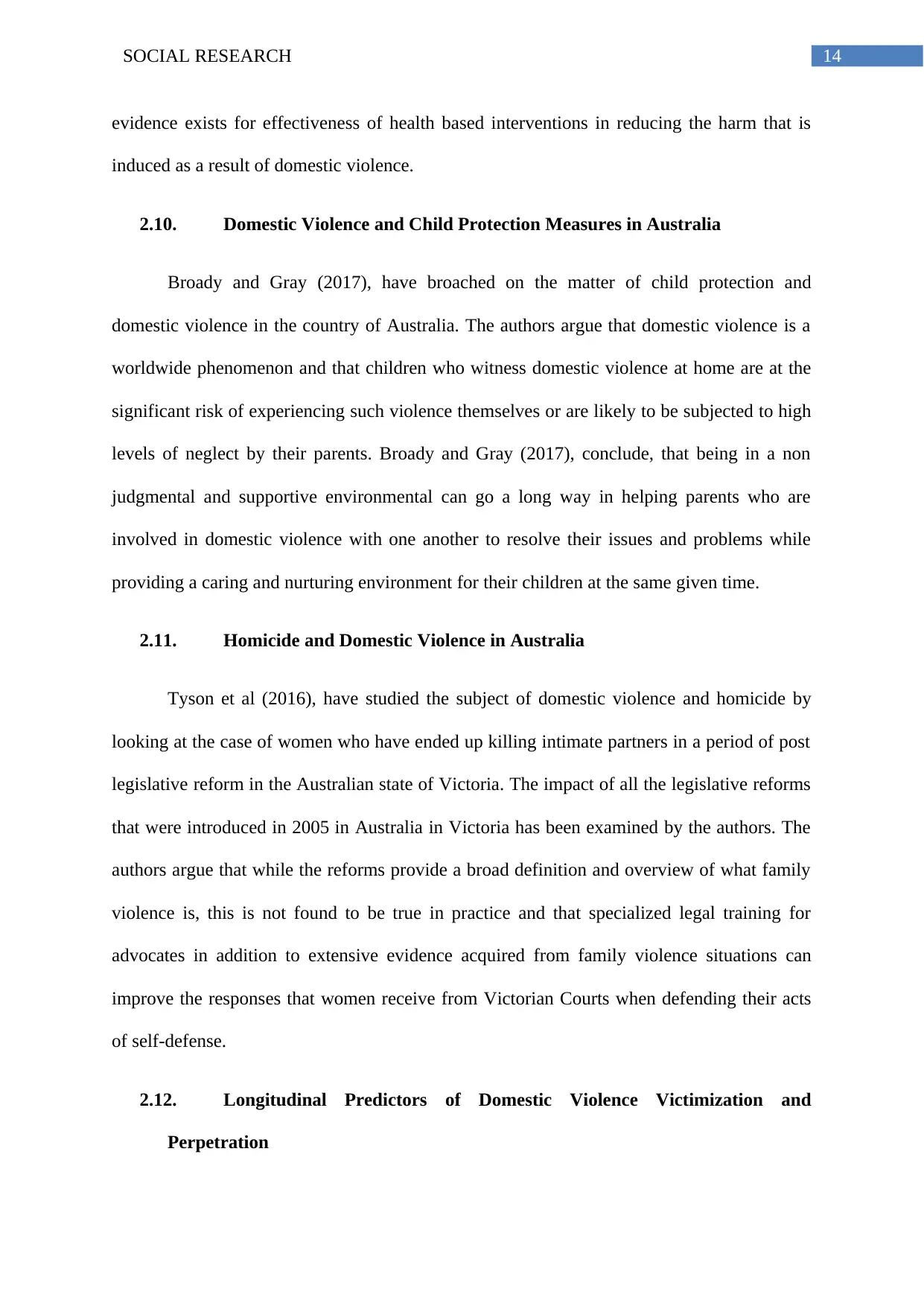
14SOCIAL RESEARCH
evidence exists for effectiveness of health based interventions in reducing the harm that is
induced as a result of domestic violence.
2.10. Domestic Violence and Child Protection Measures in Australia
Broady and Gray (2017), have broached on the matter of child protection and
domestic violence in the country of Australia. The authors argue that domestic violence is a
worldwide phenomenon and that children who witness domestic violence at home are at the
significant risk of experiencing such violence themselves or are likely to be subjected to high
levels of neglect by their parents. Broady and Gray (2017), conclude, that being in a non
judgmental and supportive environmental can go a long way in helping parents who are
involved in domestic violence with one another to resolve their issues and problems while
providing a caring and nurturing environment for their children at the same given time.
2.11. Homicide and Domestic Violence in Australia
Tyson et al (2016), have studied the subject of domestic violence and homicide by
looking at the case of women who have ended up killing intimate partners in a period of post
legislative reform in the Australian state of Victoria. The impact of all the legislative reforms
that were introduced in 2005 in Australia in Victoria has been examined by the authors. The
authors argue that while the reforms provide a broad definition and overview of what family
violence is, this is not found to be true in practice and that specialized legal training for
advocates in addition to extensive evidence acquired from family violence situations can
improve the responses that women receive from Victorian Courts when defending their acts
of self-defense.
2.12. Longitudinal Predictors of Domestic Violence Victimization and
Perpetration
evidence exists for effectiveness of health based interventions in reducing the harm that is
induced as a result of domestic violence.
2.10. Domestic Violence and Child Protection Measures in Australia
Broady and Gray (2017), have broached on the matter of child protection and
domestic violence in the country of Australia. The authors argue that domestic violence is a
worldwide phenomenon and that children who witness domestic violence at home are at the
significant risk of experiencing such violence themselves or are likely to be subjected to high
levels of neglect by their parents. Broady and Gray (2017), conclude, that being in a non
judgmental and supportive environmental can go a long way in helping parents who are
involved in domestic violence with one another to resolve their issues and problems while
providing a caring and nurturing environment for their children at the same given time.
2.11. Homicide and Domestic Violence in Australia
Tyson et al (2016), have studied the subject of domestic violence and homicide by
looking at the case of women who have ended up killing intimate partners in a period of post
legislative reform in the Australian state of Victoria. The impact of all the legislative reforms
that were introduced in 2005 in Australia in Victoria has been examined by the authors. The
authors argue that while the reforms provide a broad definition and overview of what family
violence is, this is not found to be true in practice and that specialized legal training for
advocates in addition to extensive evidence acquired from family violence situations can
improve the responses that women receive from Victorian Courts when defending their acts
of self-defense.
2.12. Longitudinal Predictors of Domestic Violence Victimization and
Perpetration
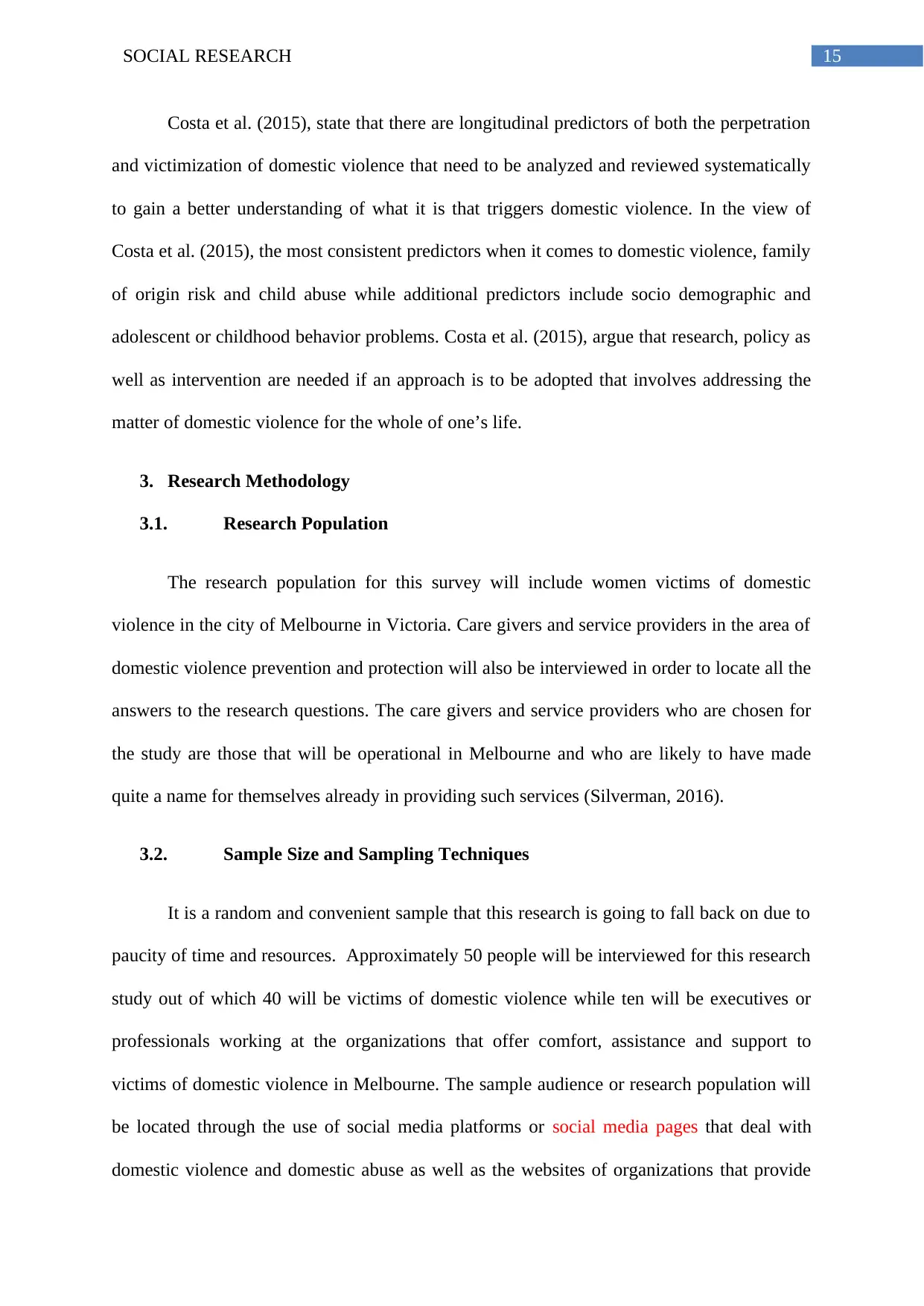
15SOCIAL RESEARCH
Costa et al. (2015), state that there are longitudinal predictors of both the perpetration
and victimization of domestic violence that need to be analyzed and reviewed systematically
to gain a better understanding of what it is that triggers domestic violence. In the view of
Costa et al. (2015), the most consistent predictors when it comes to domestic violence, family
of origin risk and child abuse while additional predictors include socio demographic and
adolescent or childhood behavior problems. Costa et al. (2015), argue that research, policy as
well as intervention are needed if an approach is to be adopted that involves addressing the
matter of domestic violence for the whole of one’s life.
3. Research Methodology
3.1. Research Population
The research population for this survey will include women victims of domestic
violence in the city of Melbourne in Victoria. Care givers and service providers in the area of
domestic violence prevention and protection will also be interviewed in order to locate all the
answers to the research questions. The care givers and service providers who are chosen for
the study are those that will be operational in Melbourne and who are likely to have made
quite a name for themselves already in providing such services (Silverman, 2016).
3.2. Sample Size and Sampling Techniques
It is a random and convenient sample that this research is going to fall back on due to
paucity of time and resources. Approximately 50 people will be interviewed for this research
study out of which 40 will be victims of domestic violence while ten will be executives or
professionals working at the organizations that offer comfort, assistance and support to
victims of domestic violence in Melbourne. The sample audience or research population will
be located through the use of social media platforms or social media pages that deal with
domestic violence and domestic abuse as well as the websites of organizations that provide
Costa et al. (2015), state that there are longitudinal predictors of both the perpetration
and victimization of domestic violence that need to be analyzed and reviewed systematically
to gain a better understanding of what it is that triggers domestic violence. In the view of
Costa et al. (2015), the most consistent predictors when it comes to domestic violence, family
of origin risk and child abuse while additional predictors include socio demographic and
adolescent or childhood behavior problems. Costa et al. (2015), argue that research, policy as
well as intervention are needed if an approach is to be adopted that involves addressing the
matter of domestic violence for the whole of one’s life.
3. Research Methodology
3.1. Research Population
The research population for this survey will include women victims of domestic
violence in the city of Melbourne in Victoria. Care givers and service providers in the area of
domestic violence prevention and protection will also be interviewed in order to locate all the
answers to the research questions. The care givers and service providers who are chosen for
the study are those that will be operational in Melbourne and who are likely to have made
quite a name for themselves already in providing such services (Silverman, 2016).
3.2. Sample Size and Sampling Techniques
It is a random and convenient sample that this research is going to fall back on due to
paucity of time and resources. Approximately 50 people will be interviewed for this research
study out of which 40 will be victims of domestic violence while ten will be executives or
professionals working at the organizations that offer comfort, assistance and support to
victims of domestic violence in Melbourne. The sample audience or research population will
be located through the use of social media platforms or social media pages that deal with
domestic violence and domestic abuse as well as the websites of organizations that provide
Secure Best Marks with AI Grader
Need help grading? Try our AI Grader for instant feedback on your assignments.
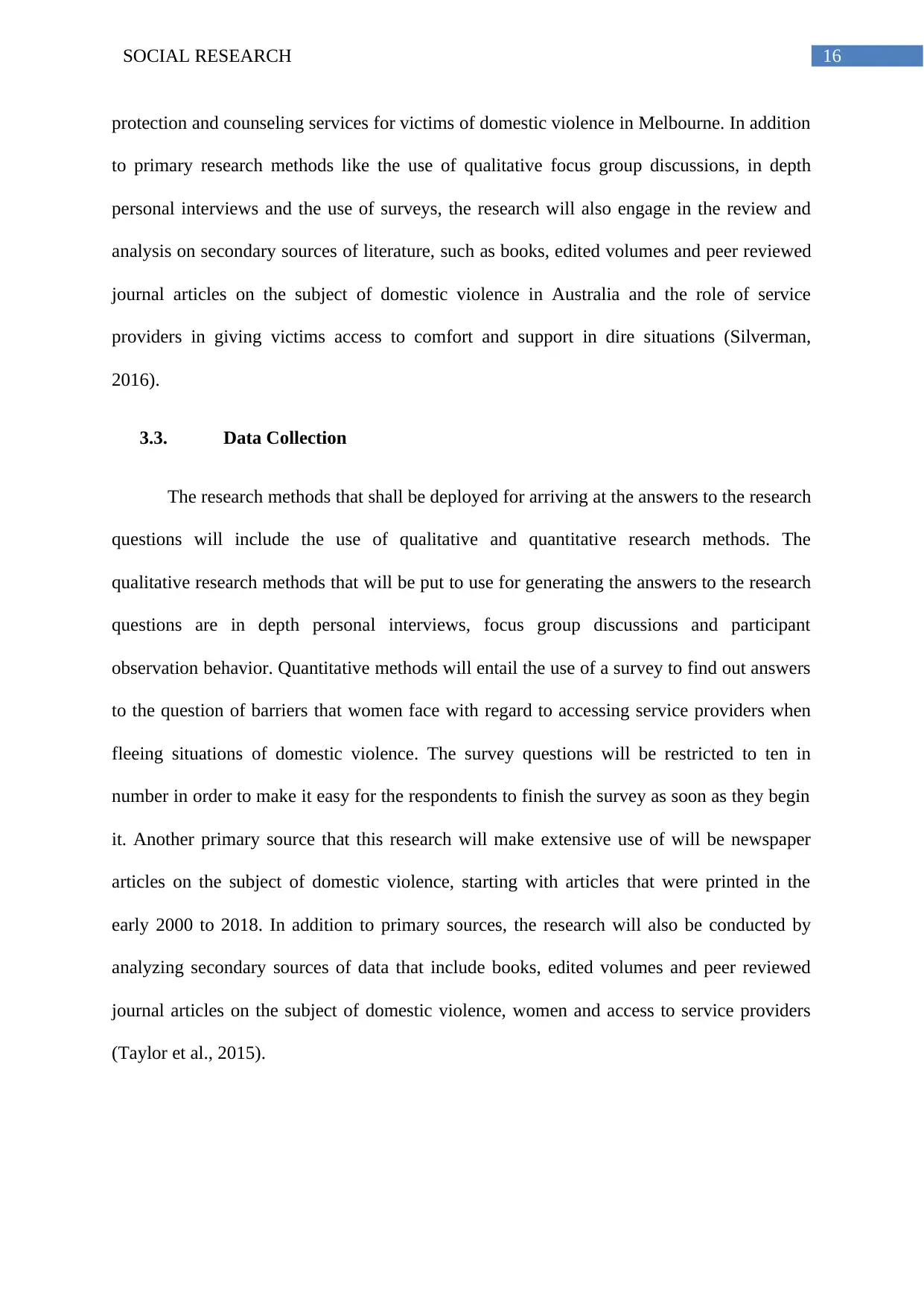
16SOCIAL RESEARCH
protection and counseling services for victims of domestic violence in Melbourne. In addition
to primary research methods like the use of qualitative focus group discussions, in depth
personal interviews and the use of surveys, the research will also engage in the review and
analysis on secondary sources of literature, such as books, edited volumes and peer reviewed
journal articles on the subject of domestic violence in Australia and the role of service
providers in giving victims access to comfort and support in dire situations (Silverman,
2016).
3.3. Data Collection
The research methods that shall be deployed for arriving at the answers to the research
questions will include the use of qualitative and quantitative research methods. The
qualitative research methods that will be put to use for generating the answers to the research
questions are in depth personal interviews, focus group discussions and participant
observation behavior. Quantitative methods will entail the use of a survey to find out answers
to the question of barriers that women face with regard to accessing service providers when
fleeing situations of domestic violence. The survey questions will be restricted to ten in
number in order to make it easy for the respondents to finish the survey as soon as they begin
it. Another primary source that this research will make extensive use of will be newspaper
articles on the subject of domestic violence, starting with articles that were printed in the
early 2000 to 2018. In addition to primary sources, the research will also be conducted by
analyzing secondary sources of data that include books, edited volumes and peer reviewed
journal articles on the subject of domestic violence, women and access to service providers
(Taylor et al., 2015).
protection and counseling services for victims of domestic violence in Melbourne. In addition
to primary research methods like the use of qualitative focus group discussions, in depth
personal interviews and the use of surveys, the research will also engage in the review and
analysis on secondary sources of literature, such as books, edited volumes and peer reviewed
journal articles on the subject of domestic violence in Australia and the role of service
providers in giving victims access to comfort and support in dire situations (Silverman,
2016).
3.3. Data Collection
The research methods that shall be deployed for arriving at the answers to the research
questions will include the use of qualitative and quantitative research methods. The
qualitative research methods that will be put to use for generating the answers to the research
questions are in depth personal interviews, focus group discussions and participant
observation behavior. Quantitative methods will entail the use of a survey to find out answers
to the question of barriers that women face with regard to accessing service providers when
fleeing situations of domestic violence. The survey questions will be restricted to ten in
number in order to make it easy for the respondents to finish the survey as soon as they begin
it. Another primary source that this research will make extensive use of will be newspaper
articles on the subject of domestic violence, starting with articles that were printed in the
early 2000 to 2018. In addition to primary sources, the research will also be conducted by
analyzing secondary sources of data that include books, edited volumes and peer reviewed
journal articles on the subject of domestic violence, women and access to service providers
(Taylor et al., 2015).
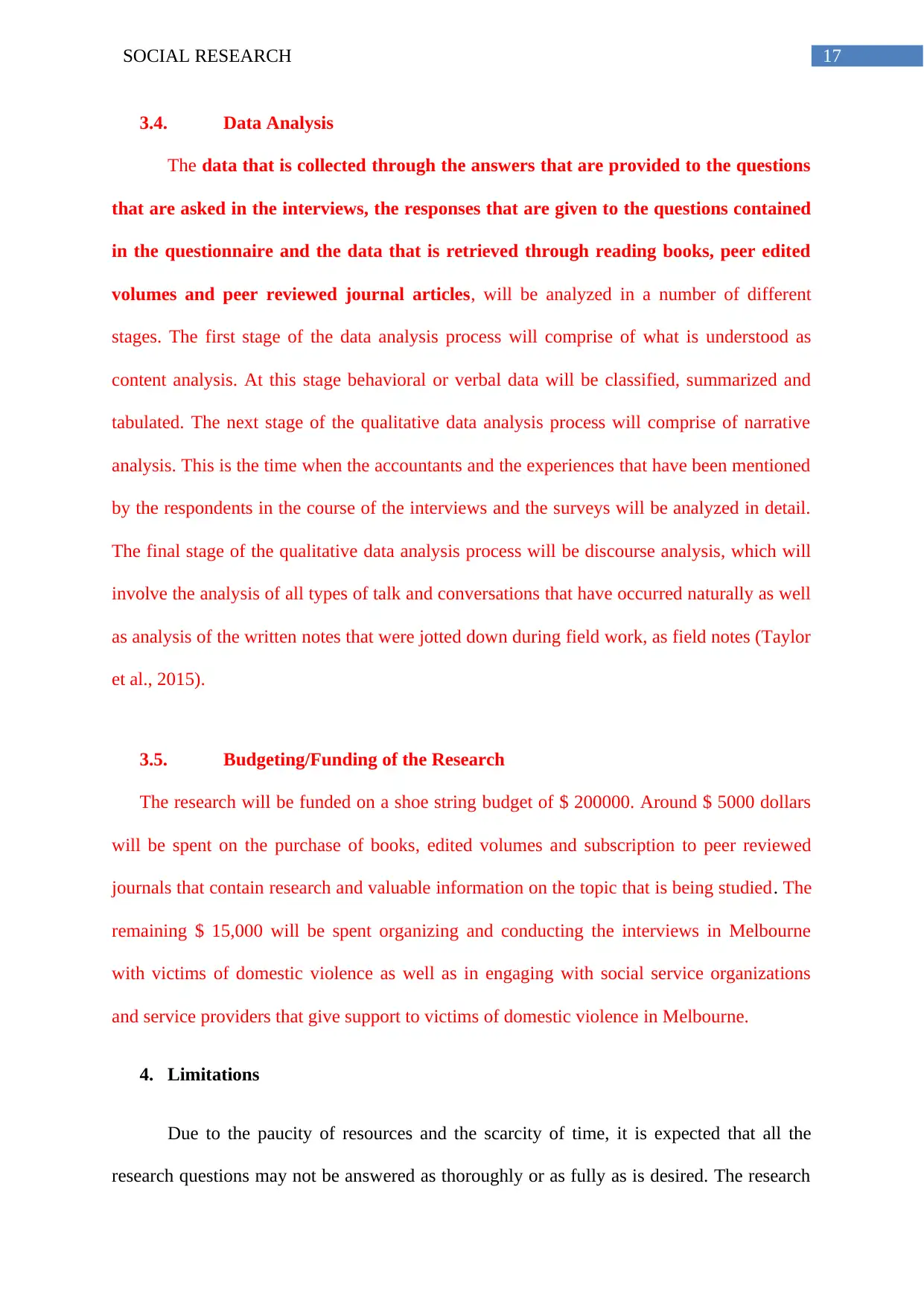
17SOCIAL RESEARCH
3.4. Data Analysis
The data that is collected through the answers that are provided to the questions
that are asked in the interviews, the responses that are given to the questions contained
in the questionnaire and the data that is retrieved through reading books, peer edited
volumes and peer reviewed journal articles, will be analyzed in a number of different
stages. The first stage of the data analysis process will comprise of what is understood as
content analysis. At this stage behavioral or verbal data will be classified, summarized and
tabulated. The next stage of the qualitative data analysis process will comprise of narrative
analysis. This is the time when the accountants and the experiences that have been mentioned
by the respondents in the course of the interviews and the surveys will be analyzed in detail.
The final stage of the qualitative data analysis process will be discourse analysis, which will
involve the analysis of all types of talk and conversations that have occurred naturally as well
as analysis of the written notes that were jotted down during field work, as field notes (Taylor
et al., 2015).
3.5. Budgeting/Funding of the Research
The research will be funded on a shoe string budget of $ 200000. Around $ 5000 dollars
will be spent on the purchase of books, edited volumes and subscription to peer reviewed
journals that contain research and valuable information on the topic that is being studied. The
remaining $ 15,000 will be spent organizing and conducting the interviews in Melbourne
with victims of domestic violence as well as in engaging with social service organizations
and service providers that give support to victims of domestic violence in Melbourne.
4. Limitations
Due to the paucity of resources and the scarcity of time, it is expected that all the
research questions may not be answered as thoroughly or as fully as is desired. The research
3.4. Data Analysis
The data that is collected through the answers that are provided to the questions
that are asked in the interviews, the responses that are given to the questions contained
in the questionnaire and the data that is retrieved through reading books, peer edited
volumes and peer reviewed journal articles, will be analyzed in a number of different
stages. The first stage of the data analysis process will comprise of what is understood as
content analysis. At this stage behavioral or verbal data will be classified, summarized and
tabulated. The next stage of the qualitative data analysis process will comprise of narrative
analysis. This is the time when the accountants and the experiences that have been mentioned
by the respondents in the course of the interviews and the surveys will be analyzed in detail.
The final stage of the qualitative data analysis process will be discourse analysis, which will
involve the analysis of all types of talk and conversations that have occurred naturally as well
as analysis of the written notes that were jotted down during field work, as field notes (Taylor
et al., 2015).
3.5. Budgeting/Funding of the Research
The research will be funded on a shoe string budget of $ 200000. Around $ 5000 dollars
will be spent on the purchase of books, edited volumes and subscription to peer reviewed
journals that contain research and valuable information on the topic that is being studied. The
remaining $ 15,000 will be spent organizing and conducting the interviews in Melbourne
with victims of domestic violence as well as in engaging with social service organizations
and service providers that give support to victims of domestic violence in Melbourne.
4. Limitations
Due to the paucity of resources and the scarcity of time, it is expected that all the
research questions may not be answered as thoroughly or as fully as is desired. The research
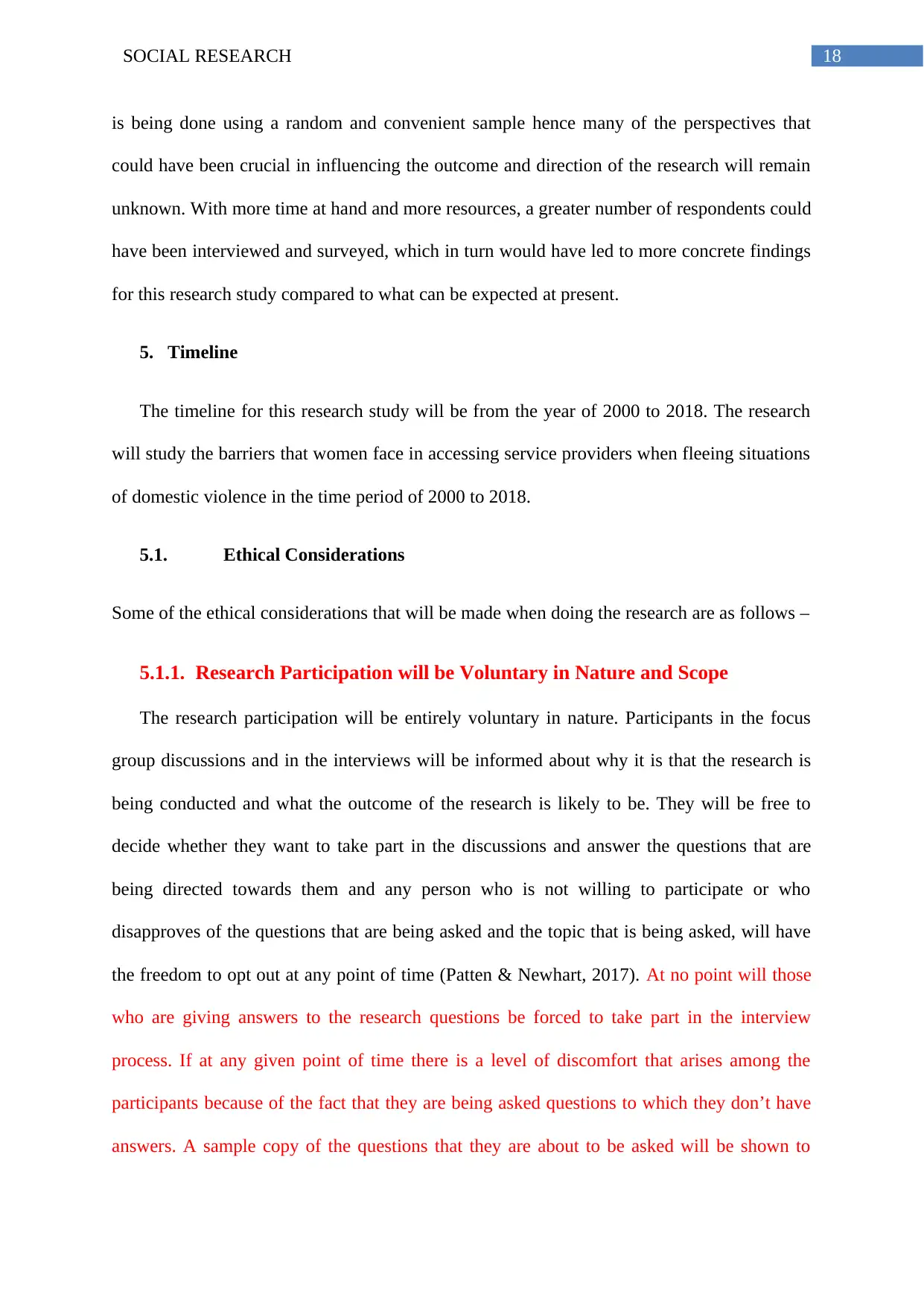
18SOCIAL RESEARCH
is being done using a random and convenient sample hence many of the perspectives that
could have been crucial in influencing the outcome and direction of the research will remain
unknown. With more time at hand and more resources, a greater number of respondents could
have been interviewed and surveyed, which in turn would have led to more concrete findings
for this research study compared to what can be expected at present.
5. Timeline
The timeline for this research study will be from the year of 2000 to 2018. The research
will study the barriers that women face in accessing service providers when fleeing situations
of domestic violence in the time period of 2000 to 2018.
5.1. Ethical Considerations
Some of the ethical considerations that will be made when doing the research are as follows –
5.1.1. Research Participation will be Voluntary in Nature and Scope
The research participation will be entirely voluntary in nature. Participants in the focus
group discussions and in the interviews will be informed about why it is that the research is
being conducted and what the outcome of the research is likely to be. They will be free to
decide whether they want to take part in the discussions and answer the questions that are
being directed towards them and any person who is not willing to participate or who
disapproves of the questions that are being asked and the topic that is being asked, will have
the freedom to opt out at any point of time (Patten & Newhart, 2017). At no point will those
who are giving answers to the research questions be forced to take part in the interview
process. If at any given point of time there is a level of discomfort that arises among the
participants because of the fact that they are being asked questions to which they don’t have
answers. A sample copy of the questions that they are about to be asked will be shown to
is being done using a random and convenient sample hence many of the perspectives that
could have been crucial in influencing the outcome and direction of the research will remain
unknown. With more time at hand and more resources, a greater number of respondents could
have been interviewed and surveyed, which in turn would have led to more concrete findings
for this research study compared to what can be expected at present.
5. Timeline
The timeline for this research study will be from the year of 2000 to 2018. The research
will study the barriers that women face in accessing service providers when fleeing situations
of domestic violence in the time period of 2000 to 2018.
5.1. Ethical Considerations
Some of the ethical considerations that will be made when doing the research are as follows –
5.1.1. Research Participation will be Voluntary in Nature and Scope
The research participation will be entirely voluntary in nature. Participants in the focus
group discussions and in the interviews will be informed about why it is that the research is
being conducted and what the outcome of the research is likely to be. They will be free to
decide whether they want to take part in the discussions and answer the questions that are
being directed towards them and any person who is not willing to participate or who
disapproves of the questions that are being asked and the topic that is being asked, will have
the freedom to opt out at any point of time (Patten & Newhart, 2017). At no point will those
who are giving answers to the research questions be forced to take part in the interview
process. If at any given point of time there is a level of discomfort that arises among the
participants because of the fact that they are being asked questions to which they don’t have
answers. A sample copy of the questions that they are about to be asked will be shown to
Paraphrase This Document
Need a fresh take? Get an instant paraphrase of this document with our AI Paraphraser
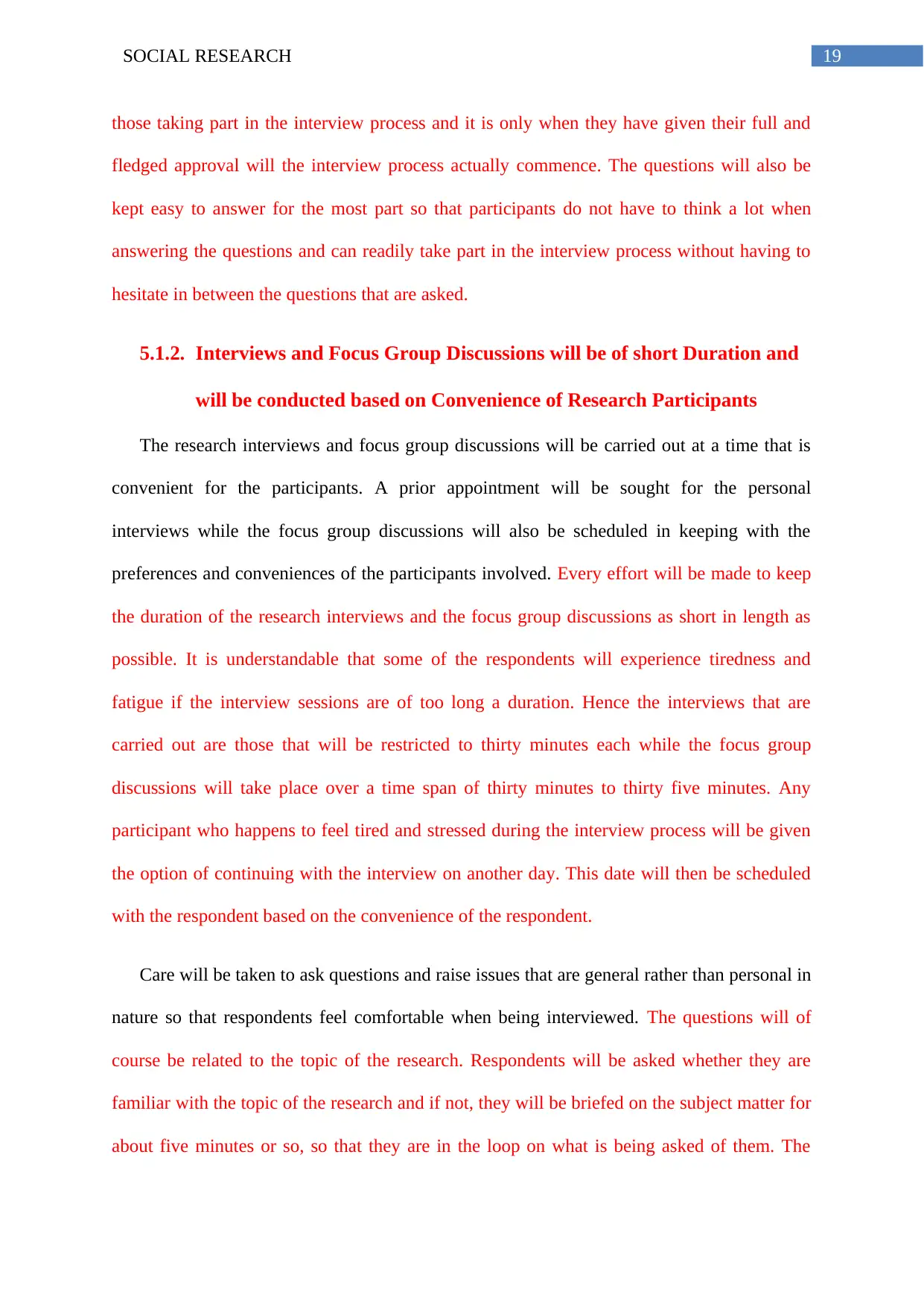
19SOCIAL RESEARCH
those taking part in the interview process and it is only when they have given their full and
fledged approval will the interview process actually commence. The questions will also be
kept easy to answer for the most part so that participants do not have to think a lot when
answering the questions and can readily take part in the interview process without having to
hesitate in between the questions that are asked.
5.1.2. Interviews and Focus Group Discussions will be of short Duration and
will be conducted based on Convenience of Research Participants
The research interviews and focus group discussions will be carried out at a time that is
convenient for the participants. A prior appointment will be sought for the personal
interviews while the focus group discussions will also be scheduled in keeping with the
preferences and conveniences of the participants involved. Every effort will be made to keep
the duration of the research interviews and the focus group discussions as short in length as
possible. It is understandable that some of the respondents will experience tiredness and
fatigue if the interview sessions are of too long a duration. Hence the interviews that are
carried out are those that will be restricted to thirty minutes each while the focus group
discussions will take place over a time span of thirty minutes to thirty five minutes. Any
participant who happens to feel tired and stressed during the interview process will be given
the option of continuing with the interview on another day. This date will then be scheduled
with the respondent based on the convenience of the respondent.
Care will be taken to ask questions and raise issues that are general rather than personal in
nature so that respondents feel comfortable when being interviewed. The questions will of
course be related to the topic of the research. Respondents will be asked whether they are
familiar with the topic of the research and if not, they will be briefed on the subject matter for
about five minutes or so, so that they are in the loop on what is being asked of them. The
those taking part in the interview process and it is only when they have given their full and
fledged approval will the interview process actually commence. The questions will also be
kept easy to answer for the most part so that participants do not have to think a lot when
answering the questions and can readily take part in the interview process without having to
hesitate in between the questions that are asked.
5.1.2. Interviews and Focus Group Discussions will be of short Duration and
will be conducted based on Convenience of Research Participants
The research interviews and focus group discussions will be carried out at a time that is
convenient for the participants. A prior appointment will be sought for the personal
interviews while the focus group discussions will also be scheduled in keeping with the
preferences and conveniences of the participants involved. Every effort will be made to keep
the duration of the research interviews and the focus group discussions as short in length as
possible. It is understandable that some of the respondents will experience tiredness and
fatigue if the interview sessions are of too long a duration. Hence the interviews that are
carried out are those that will be restricted to thirty minutes each while the focus group
discussions will take place over a time span of thirty minutes to thirty five minutes. Any
participant who happens to feel tired and stressed during the interview process will be given
the option of continuing with the interview on another day. This date will then be scheduled
with the respondent based on the convenience of the respondent.
Care will be taken to ask questions and raise issues that are general rather than personal in
nature so that respondents feel comfortable when being interviewed. The questions will of
course be related to the topic of the research. Respondents will be asked whether they are
familiar with the topic of the research and if not, they will be briefed on the subject matter for
about five minutes or so, so that they are in the loop on what is being asked of them. The
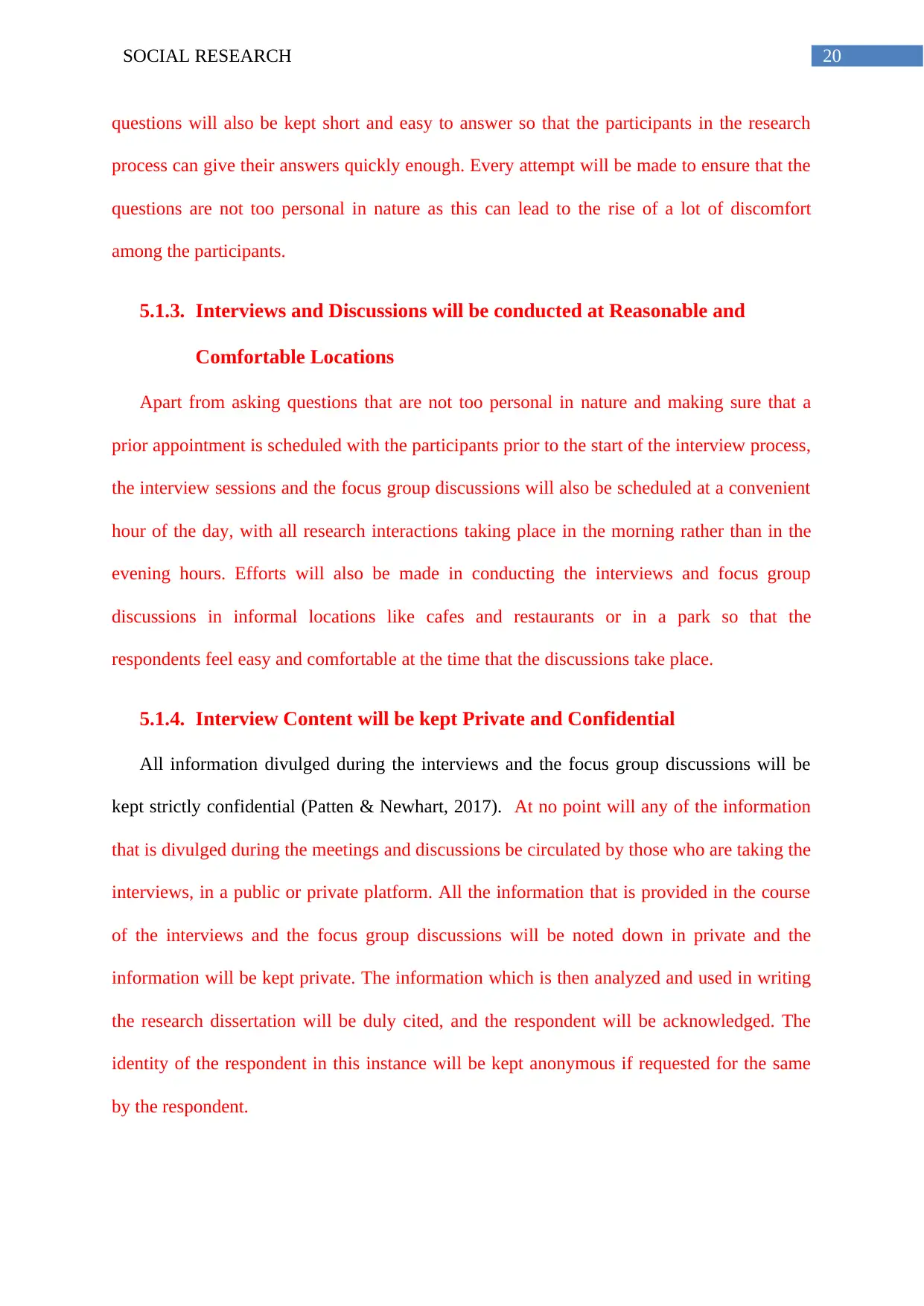
20SOCIAL RESEARCH
questions will also be kept short and easy to answer so that the participants in the research
process can give their answers quickly enough. Every attempt will be made to ensure that the
questions are not too personal in nature as this can lead to the rise of a lot of discomfort
among the participants.
5.1.3. Interviews and Discussions will be conducted at Reasonable and
Comfortable Locations
Apart from asking questions that are not too personal in nature and making sure that a
prior appointment is scheduled with the participants prior to the start of the interview process,
the interview sessions and the focus group discussions will also be scheduled at a convenient
hour of the day, with all research interactions taking place in the morning rather than in the
evening hours. Efforts will also be made in conducting the interviews and focus group
discussions in informal locations like cafes and restaurants or in a park so that the
respondents feel easy and comfortable at the time that the discussions take place.
5.1.4. Interview Content will be kept Private and Confidential
All information divulged during the interviews and the focus group discussions will be
kept strictly confidential (Patten & Newhart, 2017). At no point will any of the information
that is divulged during the meetings and discussions be circulated by those who are taking the
interviews, in a public or private platform. All the information that is provided in the course
of the interviews and the focus group discussions will be noted down in private and the
information will be kept private. The information which is then analyzed and used in writing
the research dissertation will be duly cited, and the respondent will be acknowledged. The
identity of the respondent in this instance will be kept anonymous if requested for the same
by the respondent.
questions will also be kept short and easy to answer so that the participants in the research
process can give their answers quickly enough. Every attempt will be made to ensure that the
questions are not too personal in nature as this can lead to the rise of a lot of discomfort
among the participants.
5.1.3. Interviews and Discussions will be conducted at Reasonable and
Comfortable Locations
Apart from asking questions that are not too personal in nature and making sure that a
prior appointment is scheduled with the participants prior to the start of the interview process,
the interview sessions and the focus group discussions will also be scheduled at a convenient
hour of the day, with all research interactions taking place in the morning rather than in the
evening hours. Efforts will also be made in conducting the interviews and focus group
discussions in informal locations like cafes and restaurants or in a park so that the
respondents feel easy and comfortable at the time that the discussions take place.
5.1.4. Interview Content will be kept Private and Confidential
All information divulged during the interviews and the focus group discussions will be
kept strictly confidential (Patten & Newhart, 2017). At no point will any of the information
that is divulged during the meetings and discussions be circulated by those who are taking the
interviews, in a public or private platform. All the information that is provided in the course
of the interviews and the focus group discussions will be noted down in private and the
information will be kept private. The information which is then analyzed and used in writing
the research dissertation will be duly cited, and the respondent will be acknowledged. The
identity of the respondent in this instance will be kept anonymous if requested for the same
by the respondent.

21SOCIAL RESEARCH
5.1.5. Consent will be sought for Audio and Video Recordings and the Use of
Images
The discussions and interviews will be recorded with the help of an audio recorder and
with the consent of the participants (Silverman, 2016). The audio recorder that is made use of
for this purpose will be shown to the participants and it is only and only if they are willing to
be recorded that the interview or the focus group discussion will actually be recorded.
Images and videos may be taken of the interview process and the focus group discussions
in order to ensure that the research procedure is one that comes across to be as authentic and
genuine as possible. However, the images of the participants and the videos of the focus
group discussions and interviews will be displayed briefly during the research presentation
that is made later on, only if participants give their full and final consent for doing so. This
consent will be procured from the research participants at the time of interviewing them or
holding discussions with them.
5.1.5. Consent will be sought for Audio and Video Recordings and the Use of
Images
The discussions and interviews will be recorded with the help of an audio recorder and
with the consent of the participants (Silverman, 2016). The audio recorder that is made use of
for this purpose will be shown to the participants and it is only and only if they are willing to
be recorded that the interview or the focus group discussion will actually be recorded.
Images and videos may be taken of the interview process and the focus group discussions
in order to ensure that the research procedure is one that comes across to be as authentic and
genuine as possible. However, the images of the participants and the videos of the focus
group discussions and interviews will be displayed briefly during the research presentation
that is made later on, only if participants give their full and final consent for doing so. This
consent will be procured from the research participants at the time of interviewing them or
holding discussions with them.
Secure Best Marks with AI Grader
Need help grading? Try our AI Grader for instant feedback on your assignments.
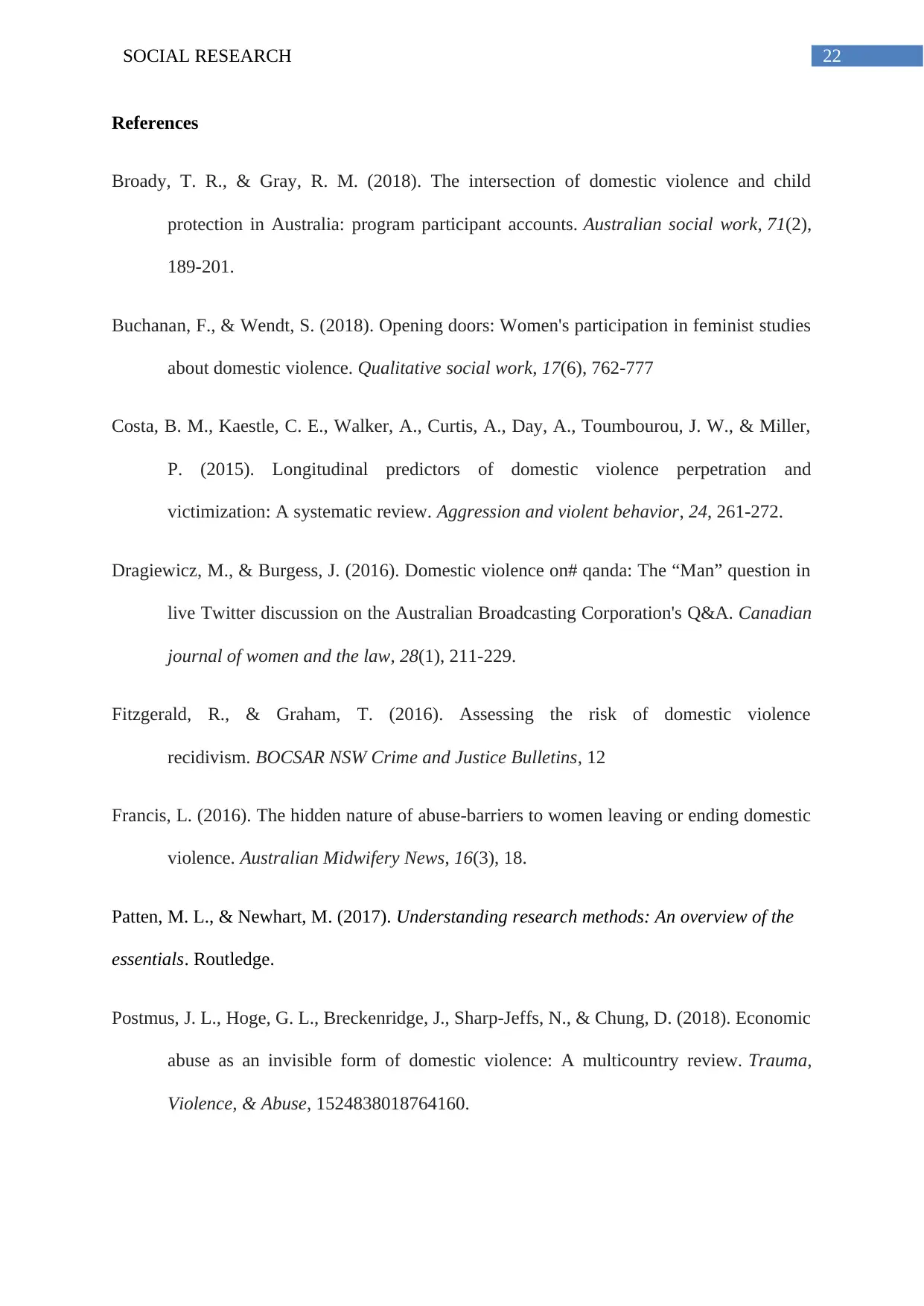
22SOCIAL RESEARCH
References
Broady, T. R., & Gray, R. M. (2018). The intersection of domestic violence and child
protection in Australia: program participant accounts. Australian social work, 71(2),
189-201.
Buchanan, F., & Wendt, S. (2018). Opening doors: Women's participation in feminist studies
about domestic violence. Qualitative social work, 17(6), 762-777
Costa, B. M., Kaestle, C. E., Walker, A., Curtis, A., Day, A., Toumbourou, J. W., & Miller,
P. (2015). Longitudinal predictors of domestic violence perpetration and
victimization: A systematic review. Aggression and violent behavior, 24, 261-272.
Dragiewicz, M., & Burgess, J. (2016). Domestic violence on# qanda: The “Man” question in
live Twitter discussion on the Australian Broadcasting Corporation's Q&A. Canadian
journal of women and the law, 28(1), 211-229.
Fitzgerald, R., & Graham, T. (2016). Assessing the risk of domestic violence
recidivism. BOCSAR NSW Crime and Justice Bulletins, 12
Francis, L. (2016). The hidden nature of abuse-barriers to women leaving or ending domestic
violence. Australian Midwifery News, 16(3), 18.
Patten, M. L., & Newhart, M. (2017). Understanding research methods: An overview of the
essentials. Routledge.
Postmus, J. L., Hoge, G. L., Breckenridge, J., Sharp-Jeffs, N., & Chung, D. (2018). Economic
abuse as an invisible form of domestic violence: A multicountry review. Trauma,
Violence, & Abuse, 1524838018764160.
References
Broady, T. R., & Gray, R. M. (2018). The intersection of domestic violence and child
protection in Australia: program participant accounts. Australian social work, 71(2),
189-201.
Buchanan, F., & Wendt, S. (2018). Opening doors: Women's participation in feminist studies
about domestic violence. Qualitative social work, 17(6), 762-777
Costa, B. M., Kaestle, C. E., Walker, A., Curtis, A., Day, A., Toumbourou, J. W., & Miller,
P. (2015). Longitudinal predictors of domestic violence perpetration and
victimization: A systematic review. Aggression and violent behavior, 24, 261-272.
Dragiewicz, M., & Burgess, J. (2016). Domestic violence on# qanda: The “Man” question in
live Twitter discussion on the Australian Broadcasting Corporation's Q&A. Canadian
journal of women and the law, 28(1), 211-229.
Fitzgerald, R., & Graham, T. (2016). Assessing the risk of domestic violence
recidivism. BOCSAR NSW Crime and Justice Bulletins, 12
Francis, L. (2016). The hidden nature of abuse-barriers to women leaving or ending domestic
violence. Australian Midwifery News, 16(3), 18.
Patten, M. L., & Newhart, M. (2017). Understanding research methods: An overview of the
essentials. Routledge.
Postmus, J. L., Hoge, G. L., Breckenridge, J., Sharp-Jeffs, N., & Chung, D. (2018). Economic
abuse as an invisible form of domestic violence: A multicountry review. Trauma,
Violence, & Abuse, 1524838018764160.
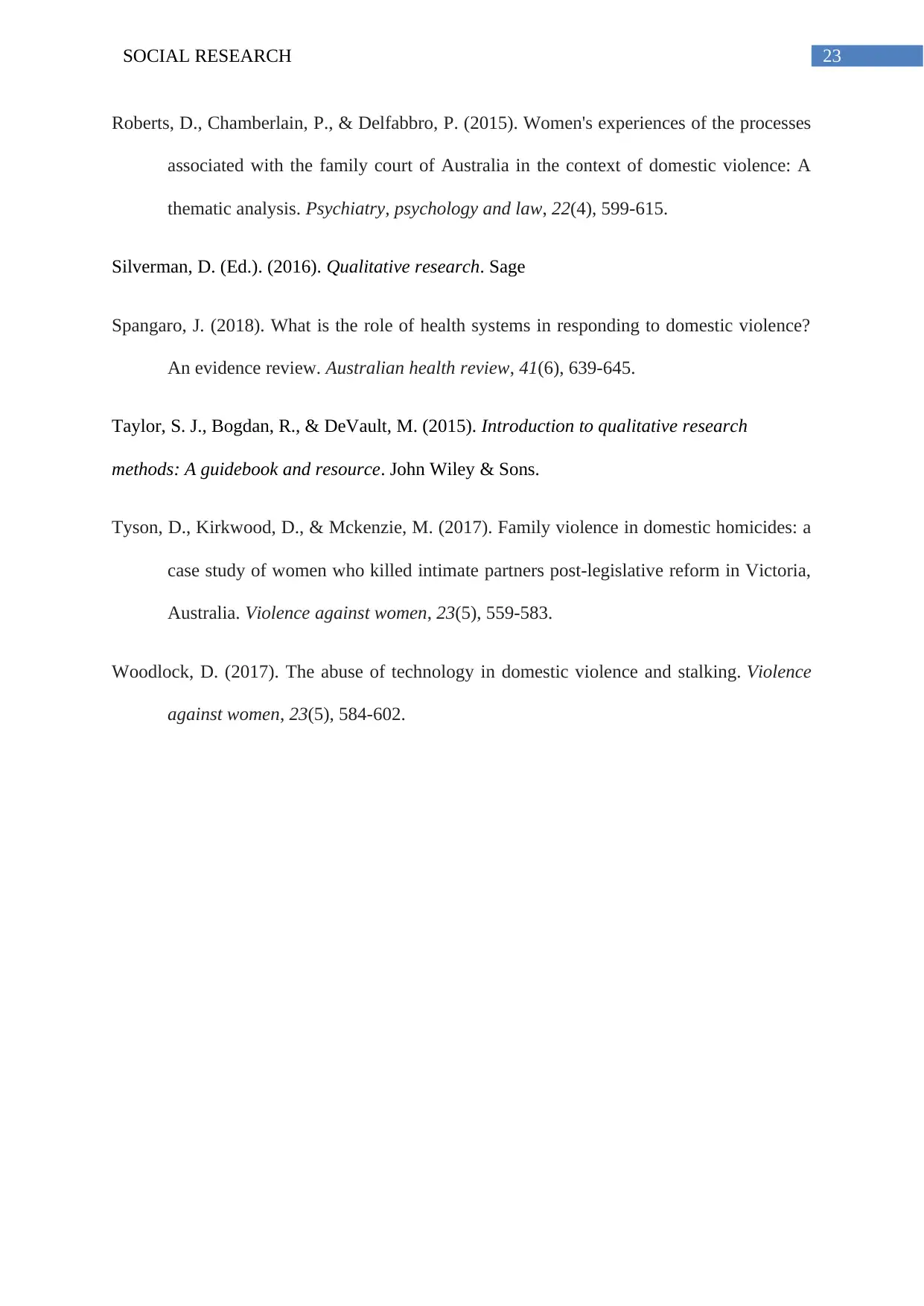
23SOCIAL RESEARCH
Roberts, D., Chamberlain, P., & Delfabbro, P. (2015). Women's experiences of the processes
associated with the family court of Australia in the context of domestic violence: A
thematic analysis. Psychiatry, psychology and law, 22(4), 599-615.
Silverman, D. (Ed.). (2016). Qualitative research. Sage
Spangaro, J. (2018). What is the role of health systems in responding to domestic violence?
An evidence review. Australian health review, 41(6), 639-645.
Taylor, S. J., Bogdan, R., & DeVault, M. (2015). Introduction to qualitative research
methods: A guidebook and resource. John Wiley & Sons.
Tyson, D., Kirkwood, D., & Mckenzie, M. (2017). Family violence in domestic homicides: a
case study of women who killed intimate partners post-legislative reform in Victoria,
Australia. Violence against women, 23(5), 559-583.
Woodlock, D. (2017). The abuse of technology in domestic violence and stalking. Violence
against women, 23(5), 584-602.
Roberts, D., Chamberlain, P., & Delfabbro, P. (2015). Women's experiences of the processes
associated with the family court of Australia in the context of domestic violence: A
thematic analysis. Psychiatry, psychology and law, 22(4), 599-615.
Silverman, D. (Ed.). (2016). Qualitative research. Sage
Spangaro, J. (2018). What is the role of health systems in responding to domestic violence?
An evidence review. Australian health review, 41(6), 639-645.
Taylor, S. J., Bogdan, R., & DeVault, M. (2015). Introduction to qualitative research
methods: A guidebook and resource. John Wiley & Sons.
Tyson, D., Kirkwood, D., & Mckenzie, M. (2017). Family violence in domestic homicides: a
case study of women who killed intimate partners post-legislative reform in Victoria,
Australia. Violence against women, 23(5), 559-583.
Woodlock, D. (2017). The abuse of technology in domestic violence and stalking. Violence
against women, 23(5), 584-602.

24SOCIAL RESEARCH
Appendix 1 – Interview Questions
Q1. Do you face violence at home? If yes, what form of violence do you experience? verbal
or physical? or both?
Q2. Have been hurt or severely injured after being at the receiving end of such violent
behavior?
Q3. Do you protest against violent behavior at home? if so, how?
Q4. When does the violent behavior take place?
Q5. What do you think triggers the violent behavior that is directed at you?
Q6. Have you sought protection against violence?
Q7. Have law enforcement authorities been helpful in providing protection?
Q8. Are there any support service providers known to you?
Q9. Have you had difficulty in contacting or reaching out to support service providers?
Q10. If you have contacted support service providers, then have they proven to be of help to
you and your specific situation of domestic violence?
Appendix 1 – Interview Questions
Q1. Do you face violence at home? If yes, what form of violence do you experience? verbal
or physical? or both?
Q2. Have been hurt or severely injured after being at the receiving end of such violent
behavior?
Q3. Do you protest against violent behavior at home? if so, how?
Q4. When does the violent behavior take place?
Q5. What do you think triggers the violent behavior that is directed at you?
Q6. Have you sought protection against violence?
Q7. Have law enforcement authorities been helpful in providing protection?
Q8. Are there any support service providers known to you?
Q9. Have you had difficulty in contacting or reaching out to support service providers?
Q10. If you have contacted support service providers, then have they proven to be of help to
you and your specific situation of domestic violence?
Paraphrase This Document
Need a fresh take? Get an instant paraphrase of this document with our AI Paraphraser
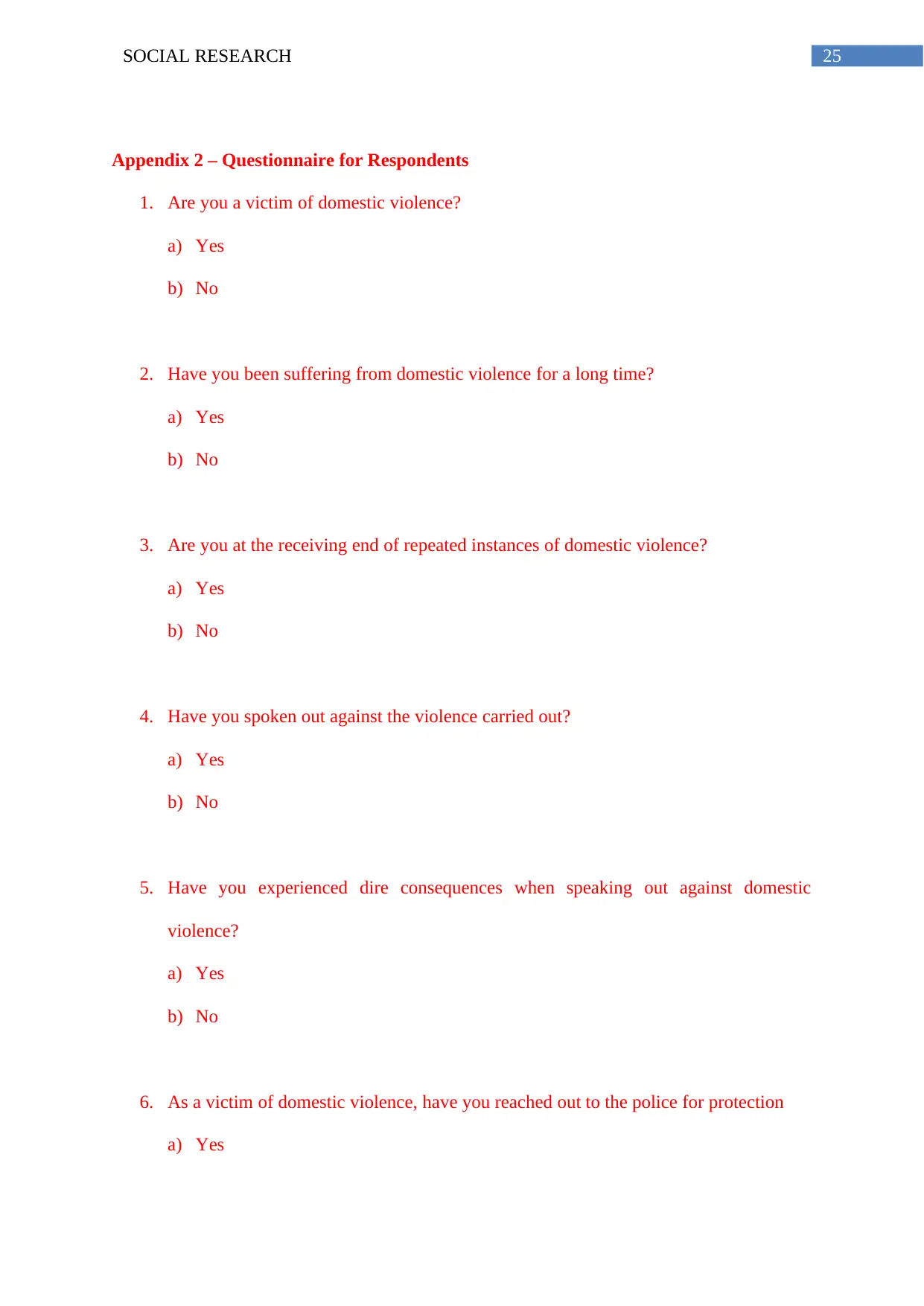
25SOCIAL RESEARCH
Appendix 2 – Questionnaire for Respondents
1. Are you a victim of domestic violence?
a) Yes
b) No
2. Have you been suffering from domestic violence for a long time?
a) Yes
b) No
3. Are you at the receiving end of repeated instances of domestic violence?
a) Yes
b) No
4. Have you spoken out against the violence carried out?
a) Yes
b) No
5. Have you experienced dire consequences when speaking out against domestic
violence?
a) Yes
b) No
6. As a victim of domestic violence, have you reached out to the police for protection
a) Yes
Appendix 2 – Questionnaire for Respondents
1. Are you a victim of domestic violence?
a) Yes
b) No
2. Have you been suffering from domestic violence for a long time?
a) Yes
b) No
3. Are you at the receiving end of repeated instances of domestic violence?
a) Yes
b) No
4. Have you spoken out against the violence carried out?
a) Yes
b) No
5. Have you experienced dire consequences when speaking out against domestic
violence?
a) Yes
b) No
6. As a victim of domestic violence, have you reached out to the police for protection
a) Yes

26SOCIAL RESEARCH
b) No
7. Have you managed to access support service providers as a victim of domestic
violence?
a) Yes
b) No
8. Have support service providers been responsive to your request for assistance?
a) Yes
b) No
9. Has your situation improved after getting in touch with support service providers?
a) Yes
b) No
10. Are you likely to contact support service providers again for the long term resolution
of your problem?
a) Yes
b) No
b) No
7. Have you managed to access support service providers as a victim of domestic
violence?
a) Yes
b) No
8. Have support service providers been responsive to your request for assistance?
a) Yes
b) No
9. Has your situation improved after getting in touch with support service providers?
a) Yes
b) No
10. Are you likely to contact support service providers again for the long term resolution
of your problem?
a) Yes
b) No
1 out of 27
Related Documents
Your All-in-One AI-Powered Toolkit for Academic Success.
+13062052269
info@desklib.com
Available 24*7 on WhatsApp / Email
![[object Object]](/_next/static/media/star-bottom.7253800d.svg)
Unlock your academic potential
© 2024 | Zucol Services PVT LTD | All rights reserved.





